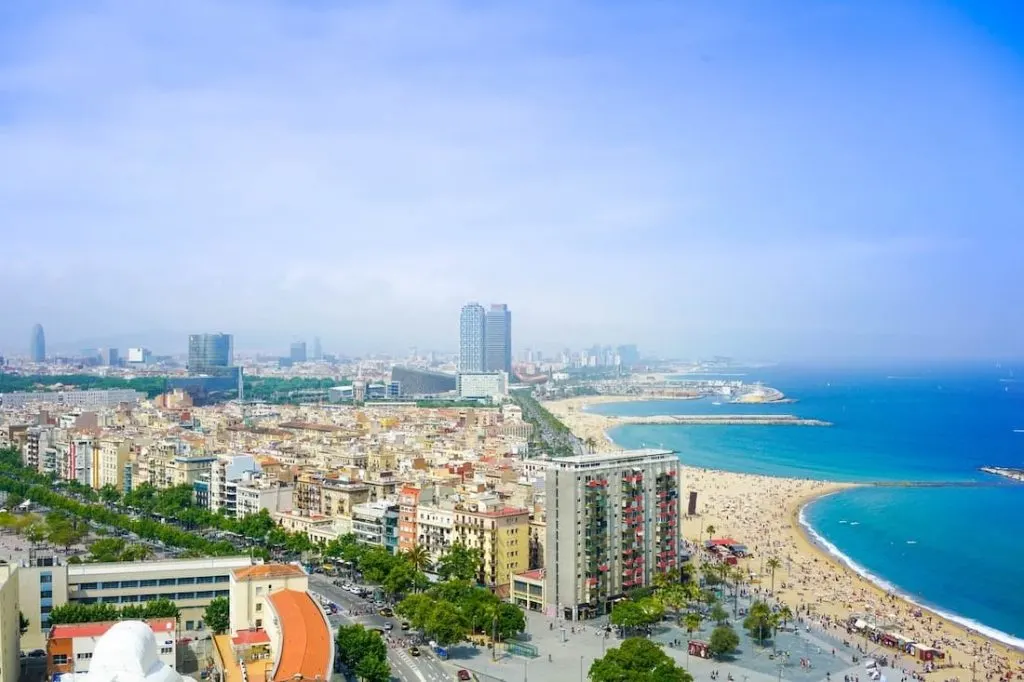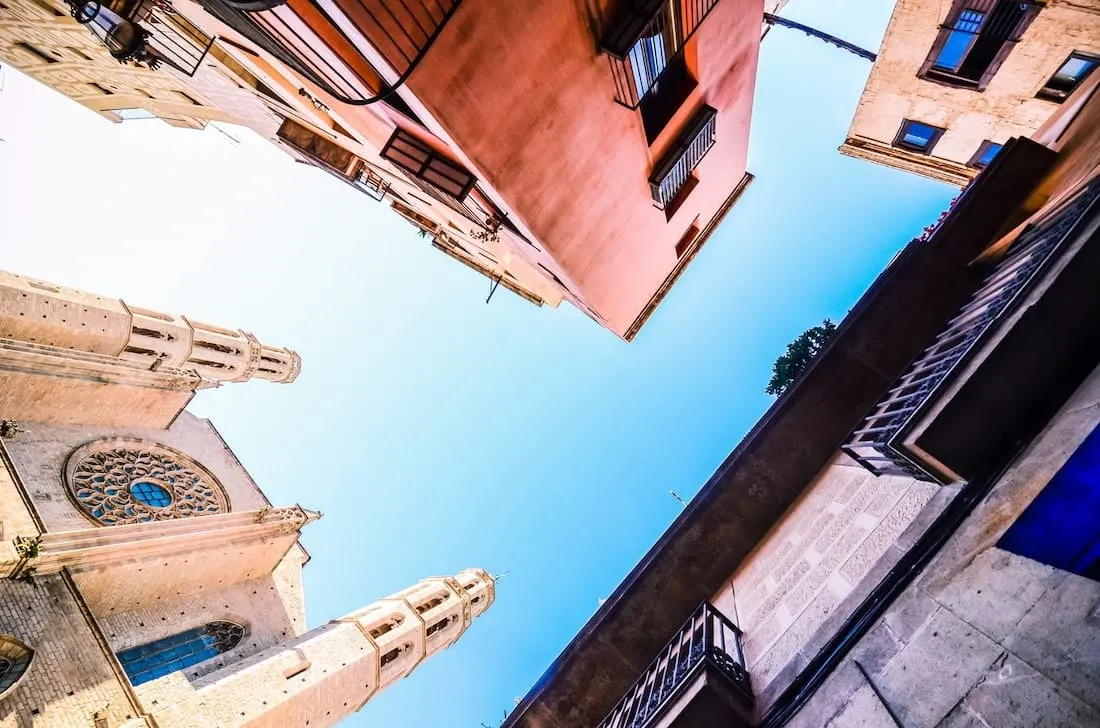Expert travel storyteller Jordan Adkins, founder of InspiredByMaps.com, brings a decade of adventures across 101 countries and 450+ UNESCO sites into rich, off-the-beaten-path narratives, melding ecological expertise with genuine, seasoned travel insights. His full bio can be found here.
Spain is one of the world’s most sought-after travel destinations, a sun-drenched nation devoted to ‘the good life’ filled with passion, epic landscapes, incredible food, and history. So much history!
Spain still retains many treasures from the civilizations of history which have risen, fallen, conquered, or left its territory – including the Spanish Empire, one of the largest and most powerful empires in history.
Thankfully today, things are a little more subdued – but the inherited architectural jewels of Old Spain remain for tourists to fawn over. Along with plenty of modernist creations and divine natural landscapes.
A landmark is a recognizable natural or artificial feature that typically stands out from its environment and has become a local or national symbol. For modern tourists, a landmark is useful for navigation – in terms of a physical waypoint and trying to help you organize your itinerary.
Getting the off-the-beaten-track is all well and good, but at the end of the day – there are some spots you just have to see when you visit a country. Think about the White House in Washington DC or Marina Bay Sands in Singapore. It would be almost inconceivable to skip such iconic spots….and why would you want to?
When approaching a trip to the lands of fiestas and flamenco, you will want to tick off as many famous Spanish landmarks as you can – and the best way is to do that is often by renting a car or making the most of a Eurail pass. To reach Spains’s two archipelagos: the Canary Islands off North Africa and the Balearic Islands in the Mediterranean – flying is easiest.
As the fourth-largest country by area on the European continent, there is a lot to explore in Spain…and no list of famous Spanish landmarks could ever be exhaustive. But, we have tried to get the highlights by putting a call out to our few travel bloggers – and asking them to tell us about their favorite.
This way, you have a reasonable frame of reference to inspire your Spanish travels where you can choose a few that you absolutely cannot miss… or cram as many as possible into one trip.
If you plan it right and have enough time, you might just hit them all — plus discover plenty more of your own highlights of Spain while you’re at it!
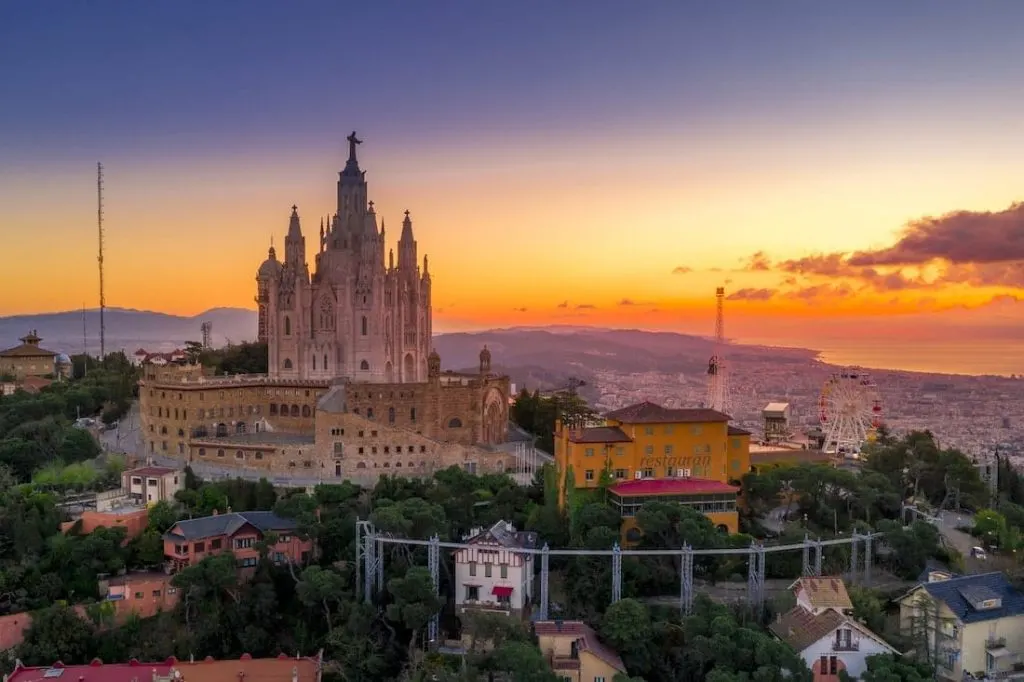
35 Famous Spanish Landmarks To Plan Your Travels Around! 🇪🇸
Page Contents
- 35 Famous Spanish Landmarks To Plan Your Travels Around! 🇪🇸
- #1. Torre De Hercules in La Coruna
- #2. Mount Teide on Tenerife
- #3. Santiago Bernabéu in Madrid
- #4. The Guggenheim Museum in Bilbao
- #5. Setenil de las Bodegas
- #6. The Royal Palace in Madrid
- #7. The Alhambra in Granada
- #8. Drach Caves in Majorca
- #9. Our Lady of Covadonga in Asturias
- #10. Monastery of Santa María de Guadalupe
- #11. Santiago De Compostela Cathedral
- #12. La Lonja in Valencia
- #13. Montserrat Cathedral Outside of Barcelona
- #14. The Dunes of Maspalomas
- #15. El Tajo Gorge in Ronda
- #16. Roman Amphitheatre in Malaga
- #17. Metropol Parasol in Seville
- #18. Timanfaya Park in Lanzarote
- #19. Benidorm Skyline
- #20. Mezquita-Catedral in Córdoba
- #21. The Alcazaba of Malaga
- #22. Las Médulas Gold Mines
- #23. El Capricho De Gaudí in Cantabria
- #24. The Roman Amphitheater in Tarragona
- #25. Colomares Castle in Benalmadena
- #26. The Alcazar in Cordoba
- #27. La Sagrada Familia in Barcelona
- #28. The Aqueduct of Segovia
- #29. Plaza De Espana in Seville
- #30. Parc Guell in Barcelona
- #31. The City of Arts and Sciences in Valencia
- #32. La Seu in Palma De Mallorca
- #33. Alcazar of Seville
- #34. Itallica
- #35. Barcelona City Beach
#1. Torre De Hercules in La Coruna
Whilst a height of 55m might not sound so impressive compared to other well-known monuments, the Tower of Hercules in the North-West of Spain is a site with a lot of history, dating all the way back to the 2nd century.
Originally built by the Romans as a lighthouse, the tower still functions today and is the oldest working lighthouse in the world. The outside walls of the tower you see today were actually built in 1789 to protect the original structure, which stands inside those outer walls.
For just €3, you can climb the Tower of Hercules to the observation deck at the top and admire the spectacular views across the jagged, rocky coastline so typical of this part of Spain. To reach the top, you’ll first have to deal with just over 200 steps (unfortunately, there is no elevator), which also gives you the opportunity to see the original Roman-built walls of the tower on the inside.
It’s a good idea to bring a jacket to the Tower of Hercules, especially if you plan on climbing to the top. The exposed peninsula faces out to the open Atlantic Ocean, and it can get chilly, even on hot days. Below the tower is the ‘Rosa de Los Vientos,’ a large compass with flags from the eight Celtic nations such as Scotland, Ireland, Brittany, and Galicia itself.
The Tower of Hercules is located a little over 2km from the center of La Coruña, the largest city in the community of Galicia. The best way to get there is to take bus number 3 from the center of La Coruña. However, a walk along the picturesque coast to the tower is nothing too strenuous and should take only 30 minutes from Praza María Pita in the center. You’ll also be able to enjoy great views on the way as you pass by the port and other beautiful areas of the city.
Explored by Stuart of Just Travelling Through
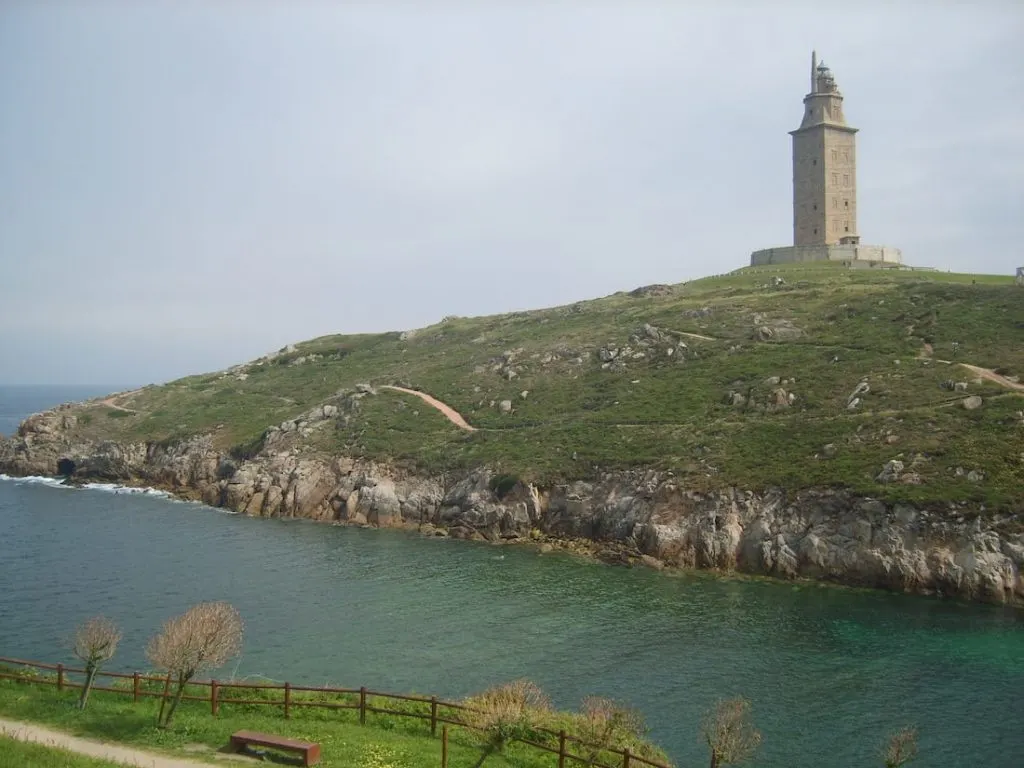
#2. Mount Teide on Tenerife
A three-hour flight from Spain’s capital Madrid lies the Canary Islands. Closer to Africa than to the Iberian Peninsula, the Canary Islands are famous for their beaches and year-round sunny weather.
While many holidaymakers come for the sun and sand, others come for the natural beauty of the islands. Formed by volcanic eruptions, the islands offer nature lovers ample opportunities to explore their unique flora and fauna. The centerpiece of the Canary Islands’ natural beauty is Mount Teide. Located on the island of Tenerife, Mount Teide, or Pico del Teide, is an active volcano. Its last eruption was in 1909 but is classified as an active volcano.
This natural landmark is Spain’s highest peak at over 12,000 feet. Mount Teide is also the most visited natural wonder in Spain. Teide National Park, which includes Mount Teide and its surrounding area, is the most visited national park in Spain. The park is accessed by private car or by public transport from the cities of Puerto de la Cruz and Playa de las Americas.
Once in the park, a cable car at the base of Mount Teide ferries visitors to the summit where they can take in the 360-degree views. With a special permit, hikers can explore parts of the summit with a licensed guide. Mount Teide has impacted not only the natural environment but also on the food and wine of Tenerife. Its rich volcanic soil is perfect for growing grapes for wine. Crops like bananas and other tropical fruits not normally associated with Spain grow perfectly on the island.
Thanks in part to Mount Teide, Tenerife’s cuisine is unique compared to the rest of Spain. When you visit Tenerife, it’s difficult not to feel Mount Teide’s presence looming over you.
Explored by Eric from Food And Drink Destinations

#3. Santiago Bernabéu in Madrid
The home of REAL Madrid – what could be a more famous landmark in Spain than this iconic soccer stadium? The Santiago Bernabéu in Madrid is the 2nd-largest stadium in Spain and the largest in Madrid with a seating capacity of 81,044.
One of the world’s most famous football venues along with Maracanã Stadium in Rio de Janeiro, it has hosted the final of four European Cup/UEFA Champions League game and the 1982 FIFA World Cup. For many, this is the holy place of football – and if you can, watching a game here is the best way to experience the atmosphere here.
Initially constructed in 1947, it is currently undergoing a half-billion euro renovation project, which will see the Santiago Bernabéu Stadium become a ‘stadium of the future’ which more restaurants, a shopping mall, and even a hotel with some rooms having pitch views!
The stadium is located in the district of Chamartín of Madrid, and the nearest subway station is Santiago Bernabéu on Line 10. Outside of game days, you can explore the onsite museum or take a tour where you will enjoy access to the pitch, Trophy Room, Presidential Balcony, dressing rooms, and more.

#4. The Guggenheim Museum in Bilbao
If you are looking for an iconic landmark in Spain’s beautiful Basque Country, look no further than the Guggenheim Museum. Located in Bilbao, the Guggenheim has attracted millions of visitors each year since it opened in 1997.
The Guggenheim is a place for Modern and Contemporary Art with a number of permanent and rotating exhibits. Not to take away from the art inside the museum, but the exterior architecture – and the symbolism the physical building holds – are also of great importance to Bilbao.
The unique building was designed by world-renowned Canadian-American architect Frank Gehry – the same person partially responsible for the “Dancing House” in Prague! His vision for an eye-catching structure certainly shows in the final design. There are even points of interest around the building, like the sculpture of Silver Balls.
Most notably, the Guggenheim Museum in Bilbao is credited for bringing the city to life. In the past, the city was not a beacon of culture and struggled due to its dying industries. That changed when the Guggenheim was built because it started attracting visitors to the city – and lots of them.
As a result, the city has had a bit of a renaissance in recent decades and has been rejuvenated to focus on its strengths. Bilbao is now much more of a service-industry focussed city and a great destination to experience Basque culture. This shift in Bilbao has been studied and referred to as the “Guggenheim Effect”!
The Guggenheim Museum is located right in the heart of the city center of Bilbao on La Ría, as the estuary running through Bilbao is called. This makes it a great place to visit in Bilbao and allows you to walk the lovely waterway to find other attractions close by when you are done checking it out!
Explored by Lisa and Eric from Penguin and Pia
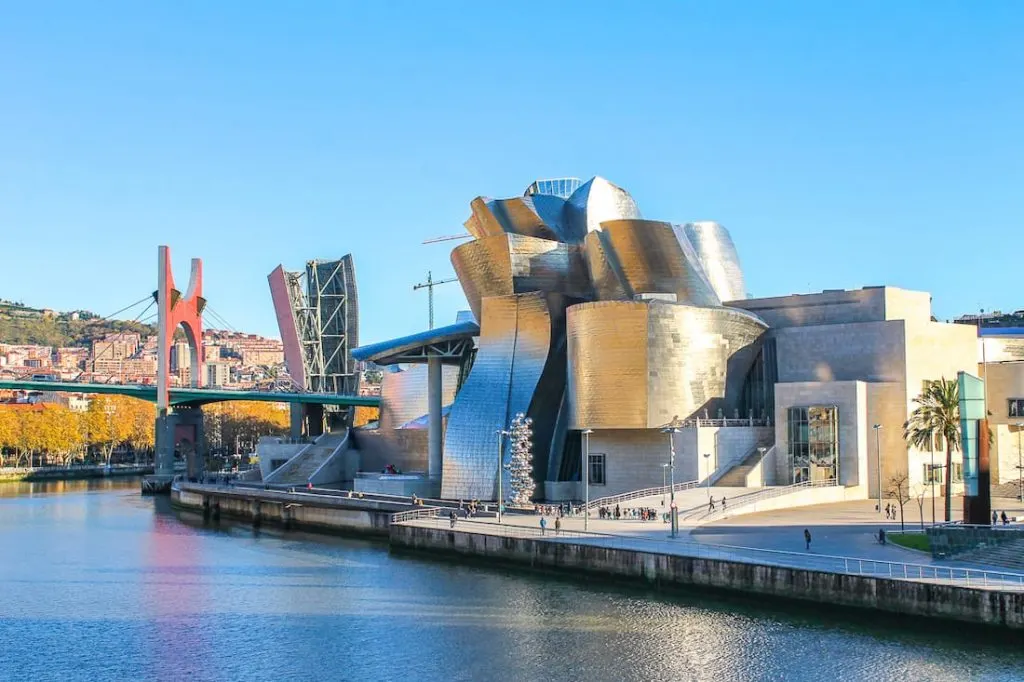
#5. Setenil de las Bodegas
Have you ever wondered what it would be like to actually live inside a mountain? Well, wonder no more and add Setenil de las Bodegas to your Spain itinerary. This incredible little village is far removed from any of the tourist guidebooks, but it’s definitely worth a visit as you’re exploring the south of Spain.
Located just 1.5 hours from Seville, Setenil de las Bodegas seems at a distance like other whitewashed villages, pueblo blanco, throughout Andalucia, but as you approach, it becomes clear that this village is distinctly different. Many of the homes and restaurants have actually been built into the side of the mountain, which runs along the river gorge.
On arrival, you’ll notice the cliff overhang that serves as a roof for many dwellings. For others, the exterior of the homes almost seems normal, but as you enter, it is as if entering a cave with the inner portion of the home or bistro being embedded into the rock.
The origins of the pueblo are unknown, but it’s believed they date back to prehistoric times. Over centuries these caves have always been used as dwellings.
Setenil de las Bodegas is best reached by car or private driver (we visited en route from Seville to Granada). It can be reached by bus but the travel time is much longer. Even if you’re visiting for just a short while, make time to stop into one of the local tapas bars. Aside from being such a unique location, the tapas are fantastic and often include local meats such as Iberico ham and sausage.
While Setenil de las Bodegas is no longer untouched by tourists, it really isn’t busy, so it’s a wonderful location to wander without teeming crowds. Make sure to wander past the initial cliff overhangs and up the stone stairs to Mirador del Carmen for an incredible view over the town and Spanish countryside.
Explored by Joanne from Sunsets and Roller Coasters
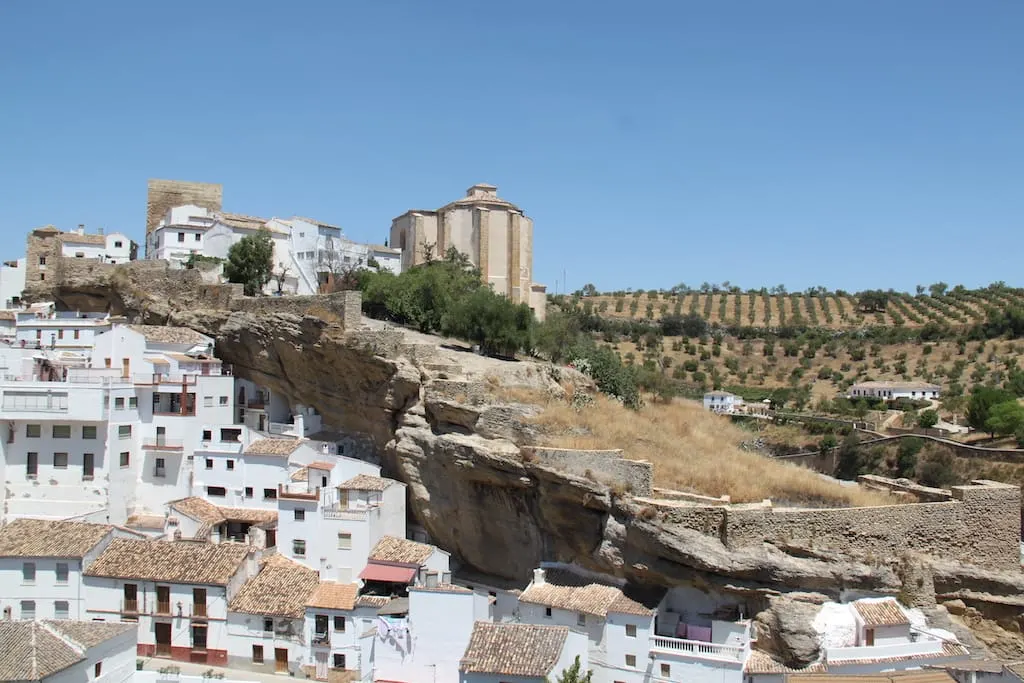
#6. The Royal Palace in Madrid
Curious to see what it’s like to live like a Spanish king? Head to the Royal Palace, one of the most iconic landmarks in Spain and a must-have on your Madrid itinerary. It was the home of the kings of Spain from Charles III to Alfonso XIII, and it is still the official royal residence. Since the current royal family does not live there, today, it is only used for state ceremonies.
Dating back to the 18th century, the current palace is a baroque masterpiece that contains more than 3000 rooms and spreads across 135,000 square meters (1,450,000 sq ft), which makes it Europe’s largest functioning palace.
Although only some of the rooms can be visited, it is certainly enough to admire the palace’s beauty and appreciate the extravagance and luxury of the Spanish monarchs’ life. That includes the Gala Dining Room, the Throne Room, the Royal Library, and more impressive chambers filled with history. From paintings by artists like Caravaggio and Francisco de Goya to silverware collections to a Stradivarius collection, this place preserves hundreds (if not thousands) of historically valuable items.
How to visit the Royal Palace: Since they limit the number of daily visitors, it is crucial to purchase your ticket in advance. You can either book a guided tour or buy a ticket on the palace’s official website, where you’ll have to pick a specific time to visit. The palace also offers free admission on certain hours during the week for citizens of the EU, as well as other specific groups of people.
By Or from My Path in the World
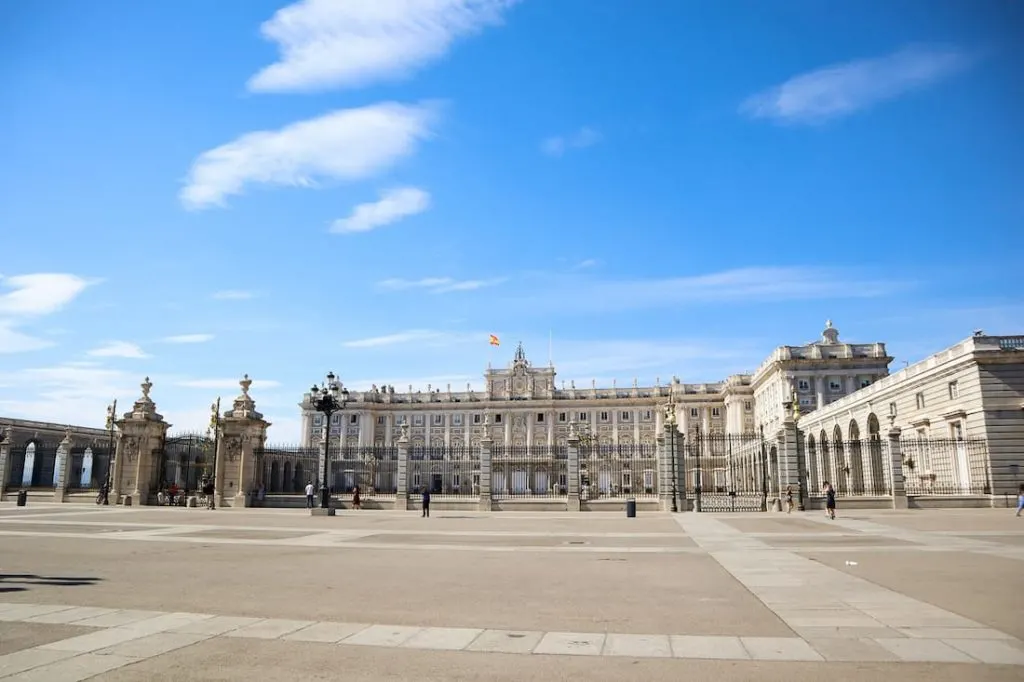
#7. The Alhambra in Granada
Spain is a country full of contrast and culture. Those two characteristics meet in the Alhambra. Located four hours south of Madrid in Grenada, it sits in the heart of Andalusia. A UNESCO World Heritage site, The Alhambra was a palace, citadel, and fortress.
It was built on the ruins of a Roman fortress dating to AD 889. It was then reconstructed in the mid-13th century and reached its splendor in the second half of the 14th century. It became the residence of the Nasrid sultans, high officials, court servers, and soldiers. Once King Ferdinand II and Queen Isabella regained power in 1492, the Alhambra became a royal palace and was later expanded by King Carlos V.
This fortress is a complex of buildings and gardens and includes the Generalife Palace – a summer palace and garden on the outside of the fortress. Visiting the Alhambra is a planned excursion. You must get timed tickets months in advance, and tickets are non-transferable. The entry time on your ticket is for entering the Nasrid Palaces – not the Alhambra complex in general.
Since you first enter through the gardens and see the Generalife Palace first, you may get distracted here and miss the timed entry. See the Nasrid Palace first! It is best to get a guided tour of the Alhambra as there is much to see and cover. You should give yourself a minimum of three hours, but setting aside half a day would not be unusual. You can drive and park below the palace complex but be prepared to walk.
Be sure and take the time to see the beautiful wood, stone, and plasterwork. The intricate patterns and design on the walls and the ceilings of the palace are amazing (considering all were built by hand in the 13th century). There is extensive Arabic script and calligraphy of poems and scripture and repeated geometric patterns found throughout the palace.
There is no question there is so much to see and why it is considered one of the New 7 Wonders of the World. The Alhambra is yet another example of amazing architecture in Spain.
Explored by Margarita Ibbott of DownshiftingPRO.com
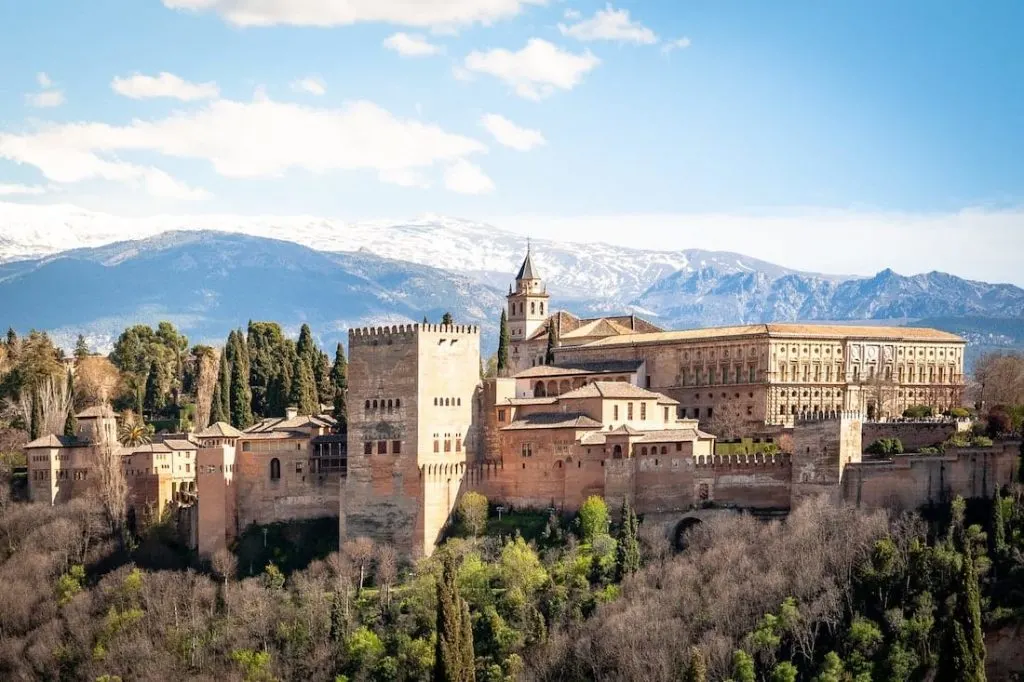
#8. Drach Caves in Majorca
One of the most famous landmarks in Spain is not actually above ground but below it – the spectacular Drach Caves in Majorca.
Along with Jeju’s lava tunnels and the glowworms caves of New Zealand, these Drach Caves are one of the world’s great subterranean wonders with four interconnected caves extended four kilometers in length. A highlight of the Balearic Islands and easily accessible from Porto Cristo the caves were formed in the Miocene Epoch by water forcing its way in from the Mediterranean Sea.
The stalactites seem to be dripping from the roof, and floating on a boat inside the underground lake here is a surreal experience. Named Lago Martel, it is considered one of the largest underground lakes in the world, and visitors can enjoy a classical concert conducted by four musicians on a boat.
Exceptionally beautiful and huge, a tour of the Drach Caves in Majorca is largely a walking tour with the addition of this boat “theater” at the end. It takes around an hour to complete, though you should take your time and allow yourself to find an uncrowded spot to really appreciate these geologic wonders. The tour length is around 1.2 kilometers, and the temperature inside is about 21°C, with humidity reaching 80%.
A magnificent place for all history, geography, science, and lovers – and one of Spain’s most famous natural attractions.
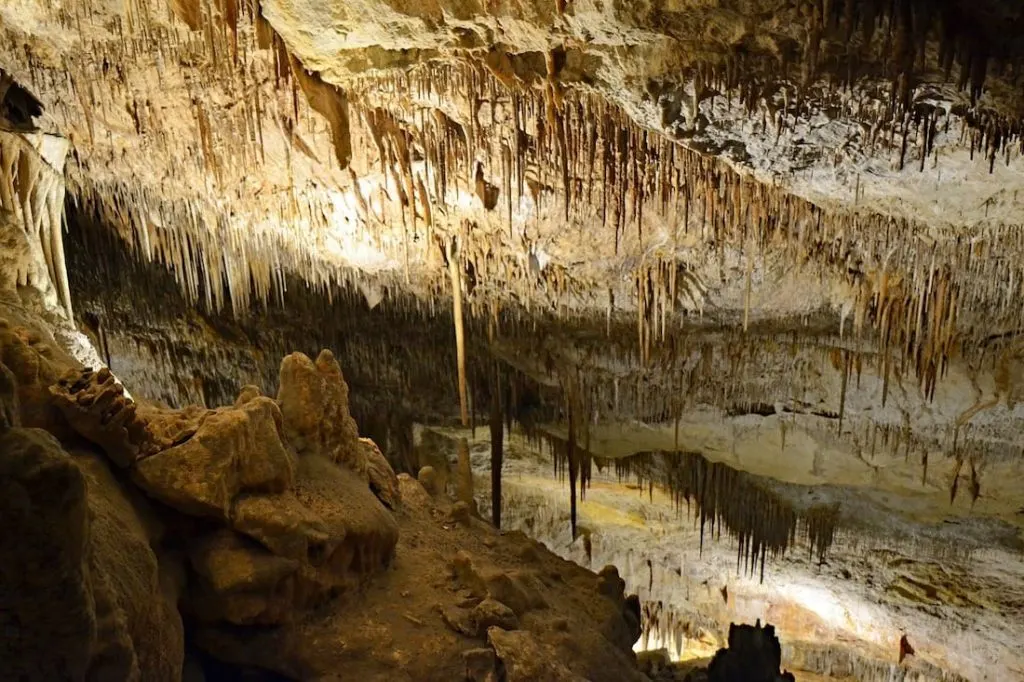
#9. Our Lady of Covadonga in Asturias
As you travel through on roads of the Picos de Europa mountain range in the northern Spain region of Asturias, you see shimmering lakes, soaring mountains, and the occasional mountain goat. As you turn a corner, you’ll be surprised to see the impressive sight of the Basilica of Our Lady of Covadonga.
Depending on the time of day, you might see the church glisten in golden yellow sunlight or blazing pink in the afternoon sun. The reason for this is that the Basilica is built entirely out of pink limestone, which can reflect sunlight. The Basilica appears larger than it actually is from a distance. It gives the appearance of an elaborately decorated cake nestled in the deep green mountains.
The Basilica holds a very special place in the heart of Spaniards. It was here in 720 CE, where King Palayo took a final stand to repel the Moors who had conquered all of Spain except Asturias. King Pelayo defeated the Moors at the Battle of Covadonga and began the reconquest of Spain that would eventually lead to the creation of modern Spain. The King credited the Virgin Mary with his victory, and the Basilica began its long construction and reconstruction to what it is today.
King Pelayo is buried in the church, along with members of his family. Inside the Basilica, you can see the icon of Our Lady of Covadonga. The church was designated a basilica in 1901.
Many people travel to Covadonga through church groups in their home city. There is also bus service from the nearby towns of Santander or Leon. By car, it is a long and circuitous route through sometimes narrow country road AS-262.
Explored by Talek of Travels With Talek
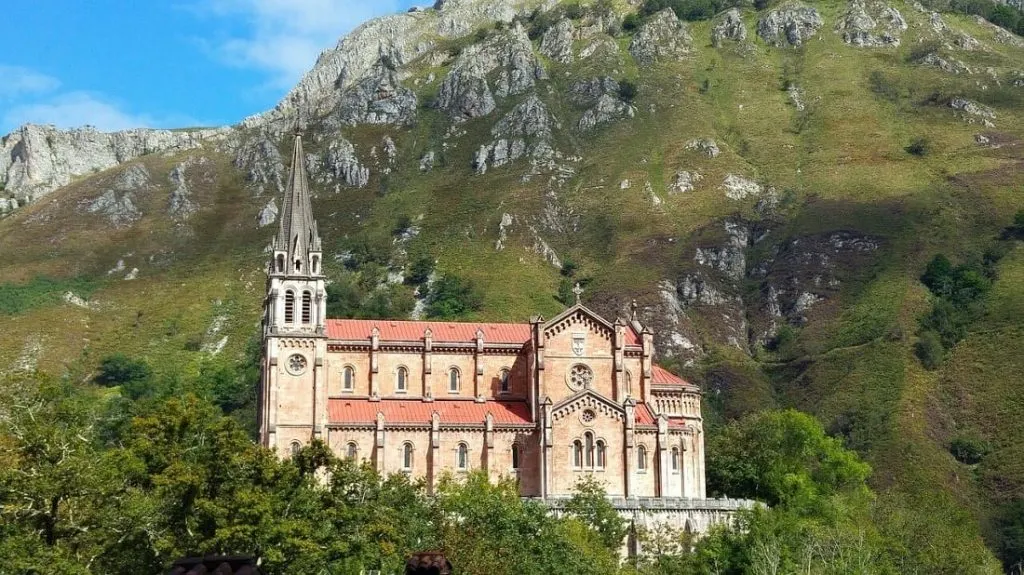
#10. Monastery of Santa María de Guadalupe
The monastery in Guadalupe in Spain has a long and illustrious history, and for centuries it was regarded as the most important monastery in all of Spain. It was constructed in the thirteenth century on the spot where a statue of the Virgin Mary had been discovered after having been hidden during the Moorish invasions of the eighth century.
Even though the monastery is well-known among domestic tourists and has been recognized as a UNESCO World Heritage Site since 1993, it is surprisingly well off the radar for most foreign tourists. This is probably because of its location in the remote western region of Extremadura, which is not often frequented by foreign travelers.
Many of the Spanish conquistadores were from Extremadura, and they spread their devotion to the Virgin of Guadalupe throughout the New World. This is why we now have a huge basilica dedicated to the Virgin of Guadalupe in Mexico City, as well as a Caribbean island named after her (the island was named by Christopher Columbus).
If you are one of the few foreign tourists who do venture out this way, you will be rewarded with the opportunity to dine and even sleep inside this magnificent historic building. It’s still a working monastery today, and the monks run a stylish restaurant with seating inside the cloister courtyard, as well as a modest guesthouse on the premises.
Buses run to Guadalupe from Madrid, and also from the nearby town of Cáceres. They are not terribly frequent, though, so you will need to plan your journey carefully.
Explored by Wendy Werneth from The Nomadic Vegan
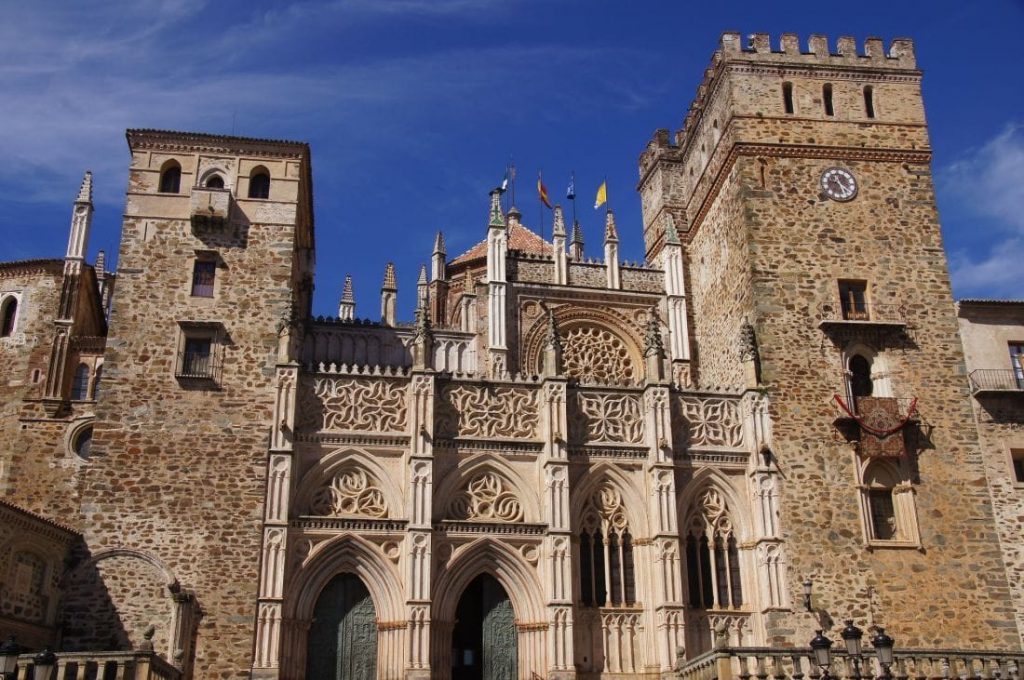
#11. Santiago De Compostela Cathedral
The Camino de Santiago (Way of St. James) is one of the world’s iconic pilgrimages, and one which has seen its popularity grow exponentially over the past decade. There are actually dozens of different Caminos, all starting in different cities around Spain and throughout Europe.
They all follow different trekking routes lasting from several days to several months. The one thing they all have in common, though, is that all roads lead to Santiago de Compostela, Spain, a beautiful old city in the Galicia region of western Spain. The stunning Santiago de Compostela cathedral is allegedly the final resting place of legendary St. James the Great, one of the original apostles of Jesus Christ.
Late in the 9th century, roughly 800 years after St. James first brought Christianity to the Iberian Peninsula, the first church was built above his tomb, leading to the first pilgrimages. While the original church only lasted about 150 years before being destroyed by the Moors, its replacement was built late in the 11th century by Alfonso VI of Castile. Based on the same plan as the Saint Semin cathedral in Toulouse, this magnificent structure still stands today as one of the most impressive in all of Spain, despite plenty of worthy competition.
Ever greater numbers of “peregrinos” completing their pilgrimages at the foot of this classic masterpiece mean that not only is it an important historic landmark, but it is also increasingly recognized as the backdrop for photos of ragged, exhausted trekkers celebrating the end of their arduous journey.
Those lucky enough to arrive on the right day, or with the cash to request a special service, can further mark their accomplishment by enjoying a solemn and fascinating “botafumeiro” ceremony, witnessing the largest censer in the world swinging from one side of the Cathedral to the other as it billows incense—a fitting end to any great walk.
Explored by Dean Johnston and Laynni Locke of Routinely Nomadic
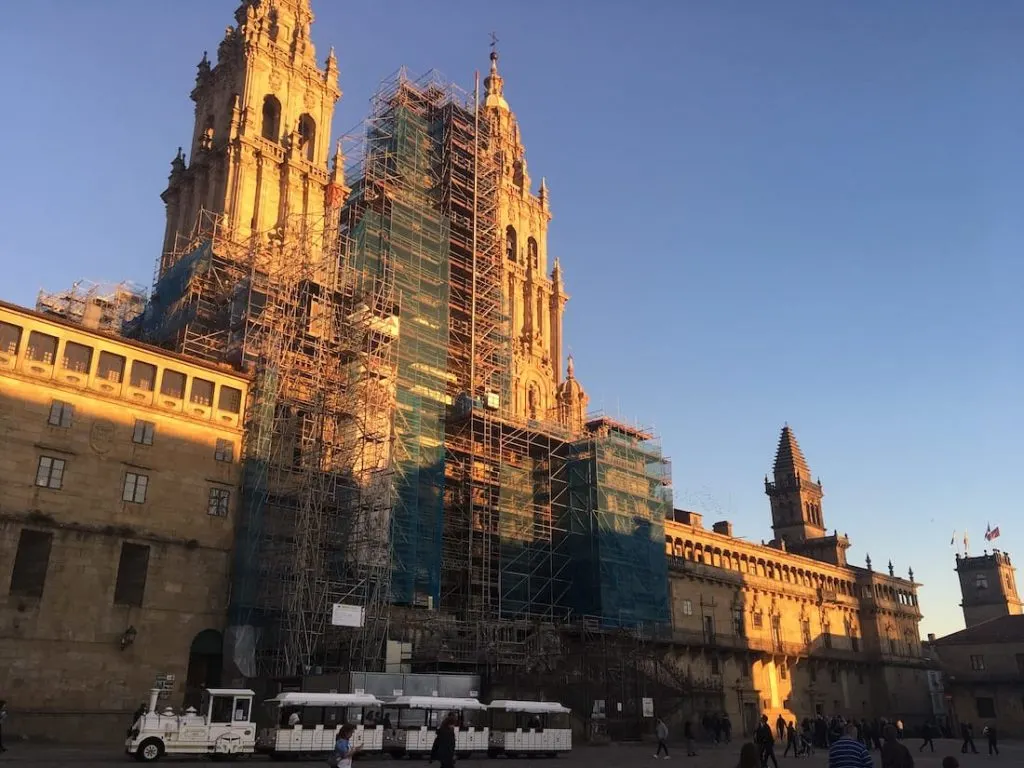
#12. La Lonja in Valencia
La Lonja de la Seda is one of the most beautiful places in Valencia, and arguably in all of Spain. It is so impressive that it has been declared a UNESCO World Heritage Site. On top of that, it only costs a couple of Euros to enter. In fact, on Sundays or public holidays, the entrance is completely free.
This stunning building dates back to the 15th century, and it’s an unusual example of a Gothic building that is not a church or a castle. Valencia used to be a thriving city for trade, and La Lonja was where merchants used to exchange their goods, especially silk. It is now famous for its vaulted ceilings and fascinating twisted columns. Just walking in here is like stepping back in time. There are three different buildings for you to explore, one of which contains a short film that explains the history of La Lonja.
Be sure not to miss the lovely orange garden nestled in between the buildings. On a hot day, sit outside under the shade of the trees with a book and enjoy the scenery and the peaceful scent of the oranges. Just be sure to behave yourself because La Lonja has its own jail! Some of the floors of La Lonja were used as prisons for merchants who didn’t pay their bills on time.
La Lonja is located right in the center of Valencia. It is within walking distance of most of the other major attractions in Valencia, like the Cathedral or the Mercado Central. Keep in mind that it is closed on Mondays.
Explored by Stella Jane from Around the World in 24 Hours
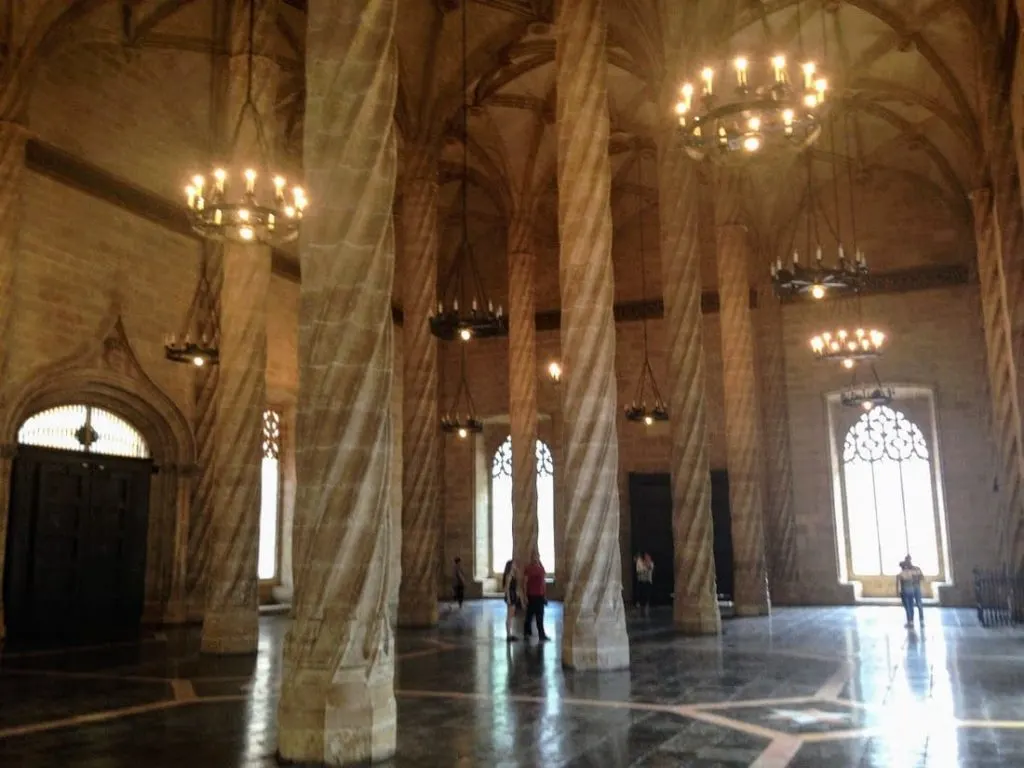
#13. Montserrat Cathedral Outside of Barcelona
Montserrat is an incredible Benedictine monastery built into the side of a mountain. Founded in the 11th century, Montserrat has an extensive history of being destroyed and rebuilt.
In 1811, Monserrat was practically demolished by Napoleon’s troops. During World War II, the Nazis went to Montserrat in an unsuccessful search for the Holy Grail that would make them invincible. At the time of Franco’s dictatorship, quite a few persecuted people were hidden there. Many historical artifacts about all the incidents and more can be found in the Montserrat museum.
In current times, pilgrims flock to Monserrat to touch the famous Black Madonna in hopes of getting a miracle. Others want to tour the church and beautiful grounds on a Barcelona day trip. One of the best reasons to visit is getting outside of the city, into nature, and taking advantage of the interesting landscape for hiking.
Getting to Montserrat is a 1 hour trip on the train from Barcelona on the R5 line from Plaça Espanya. The most exciting part of the trip is a mesmerizing cable car ride that takes you 4,000 feet up into the mountains. The train and cable car tickets cost €23 round trip. People with a car can drive up the mountain and park onsite for €6,50.
Plan your visit around the performance times of La Esconia, the 50 member boys choir that performs daily at 1:00 and 6:45 PM. Their music fills the often standing room only church and makes the experience so memorable and special. The Basilica itself is ornate and beautiful. You will see people in the area above, walking by, and touching the Black Madonna. You are welcome to join the queue for a miracle of your own.
There is a cafe if you get hungry before you venture into Montserrat National Park on one of the walking paths that will take you past chapels, shrines, and statues. There are also more challenging hiking trails accessed by taking the Saint Joan Funicular to the top. You will be blown away by the interesting landscape and stellar views.
Explored by Jenifer Byington of The Evolista
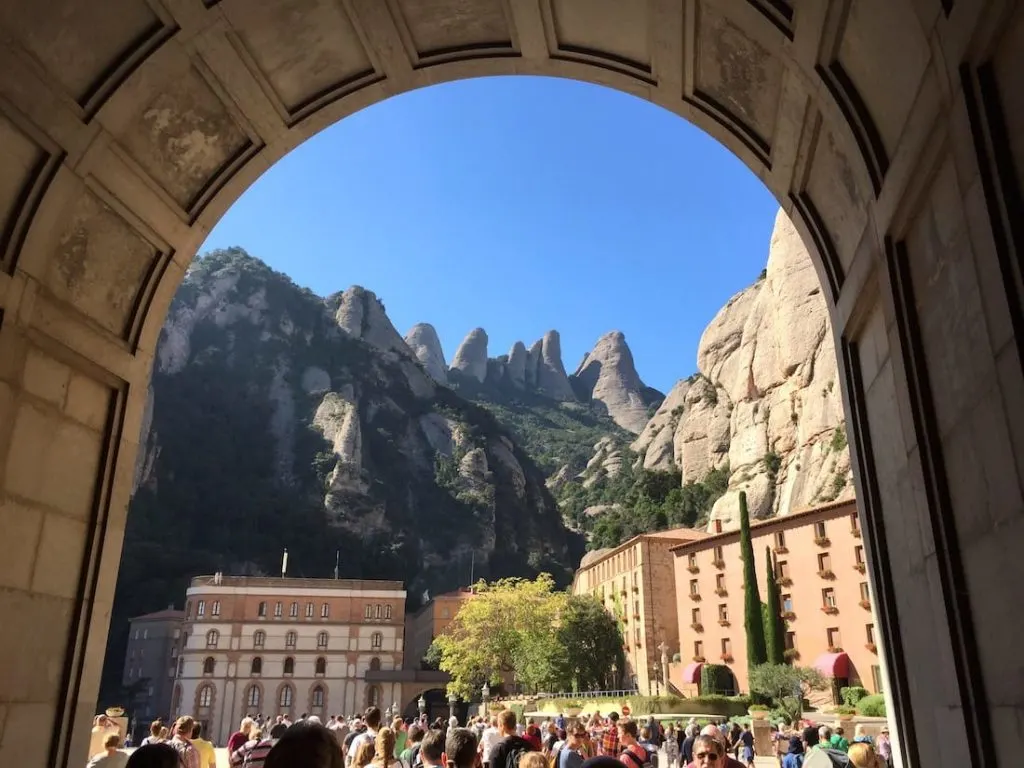
#14. The Dunes of Maspalomas
The sand dunes of Maspalomas occupy 1,000 acres and are found on the south coast of the island of Gran Canaria. Located off the northwestern coast of Africa, Gran Canaria is the second-most populous island of the Canary Islands. Though technically part of the African continent, the Canary Islands are an autonomous region of Spain.
The dunes are located just next to the city of Maspalomas, so making a visit is both simple and impressive. Better yet, they are found right next to the beach, so it’s quick and easy to visit them before or after spending a day enjoying the beach. The dunes were formed during the last ice age as sand from the now submerged marine shelf was blown towards the coast of the island.
The dunes have been a protected nature reserve since 1987 and are reminiscent of something you might see in the Sahara Desert. The dunes are most interesting to see when there is a bit of wind because you can easily observe the movements and drifting sand of the dunes, which are in constant motion and changing shape. They are conveniently located in between the town of Maspalomas and Playa del Ingles. If coming from Maspalomas, they are about a 20-minute walk from the lighthouse, called Faro Maspalomas.
If you want an amazing view of the dunes, head to the Mirador de las Dunas located at the Rui Palace Maspalomas. Gran Canaria is a pleasant place to visit year-round with average temperatures around 23C, so visiting any day will likely be great weather conditions.
Explored by Auston Matta from Two Bad Tourists
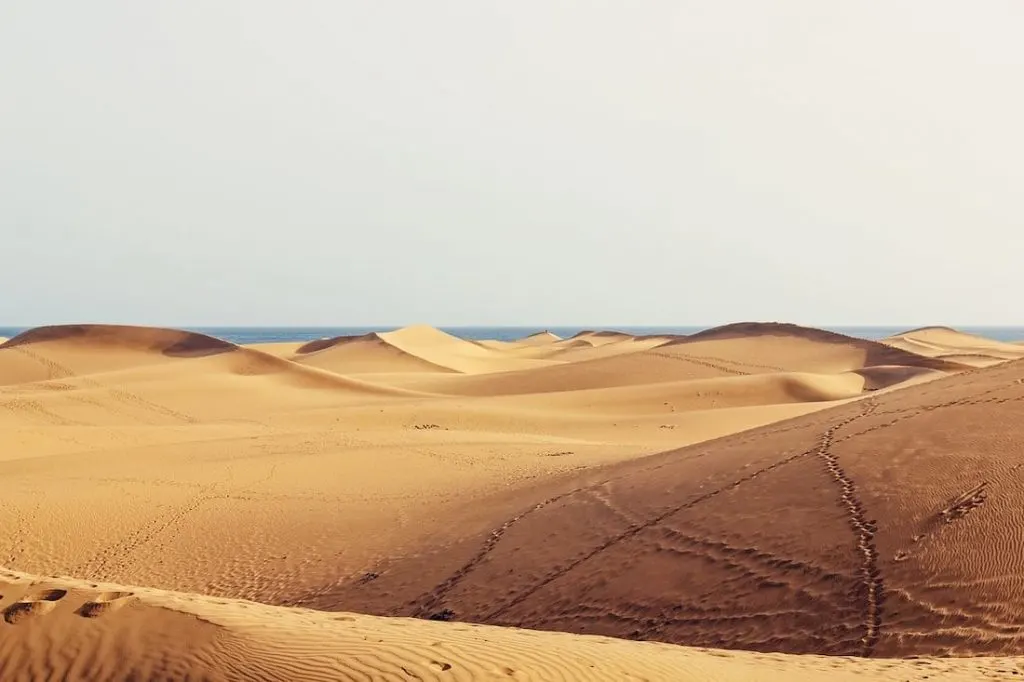
#15. El Tajo Gorge in Ronda
One of the most recognizable natural landmarks in the south of Spain is the El Tajo Gorge, located in Ronda, Spain. It is also the reason that the city of Ronda has become one of the most popular places to visit in Andalusia.
Ronda is one of the few cities in the world that is naturally divided into two halves by the Guadalevín River, which runs through the city. Located in a mountainous region, the river carves out the deep El Tajo gorge, which separates the Moorish-era old town with the new town by three bridges, the most recognizable of which is the new bridge, Puente Nuevo.
It doesn’t matter whether you only have a few hours to explore or are staying in Ronda for a week, you must follow the trail down the gorge to the heart of its valley and admire the sensational views of the arches embedded into the cliffs. You don’t need to hike down all the way into the valley if you are not a hiker or you visit in the heat of the summer, but I do encourage you to walk the path halfway or so to gain a different perspective.
If you can visit during the shoulder season, your experience will be much more pleasant as it does get quite hot in the south of Spain during the summer. Whenever you visit, make sure to bring a lot of water with you!
While you can visit by bus from many popular cities in Southern Spain, I highly recommend spending at least 24 hours in Ronda. Sit out on a terrace at one of the restaurants overlooking the El Tajo Gorge and watch as the sun begins to set. Enjoy a cava or vino and take in the silence; once the day-trippers have gone back to their respective tour buses, the setting is serene.
Explored by Jennifer from World On A Whim
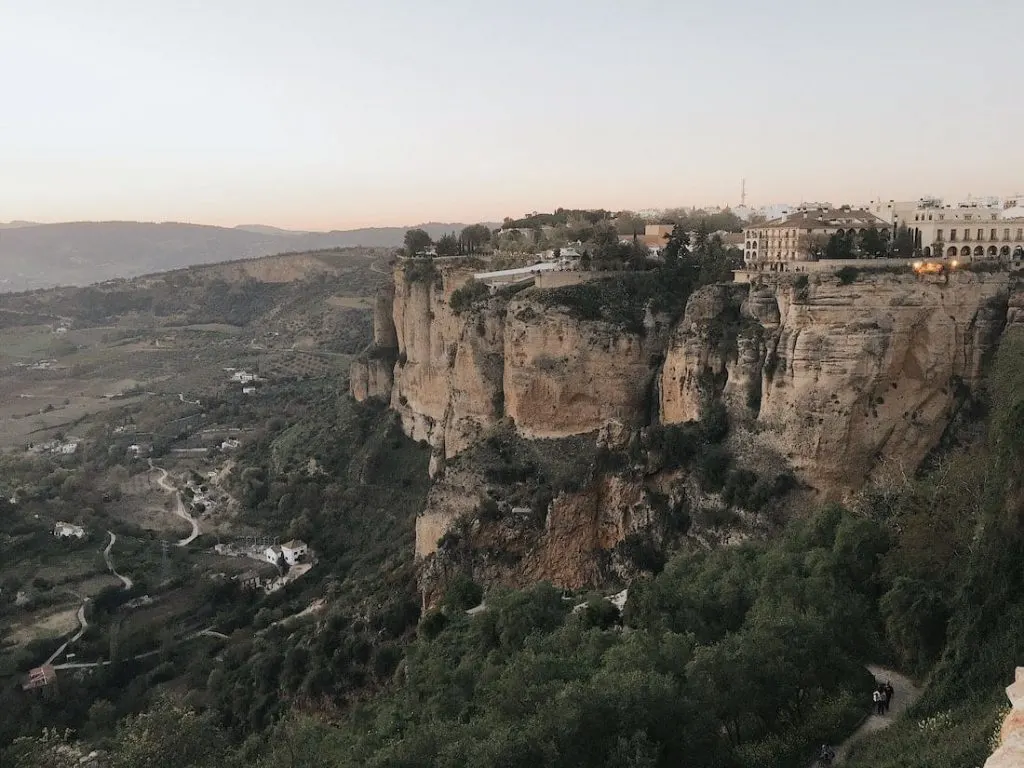
#16. Roman Amphitheatre in Malaga
El Teatro Romano, which translates to the Roman Theatre, is a Roman amphitheater which can be found in the center of Malaga. The landmark is a symbol of the city and unique in many regards, due to the fact it’s right in the center of the city.
The theatre sits at the bottom of the Alcazaba fortress and dates back to the 1st century. It’s believed the theatre was commissioned by Emperor Augustus and was used until the 3rd century.
The performances carried out in the theatre were predominately of religious origin, which was promoted by the wealthy in Malaga. Following the fall of the Roman Empire, the theatre fell into disrepair, with subsequent civilizations neglecting it. Indeed, the Moors who followed the Romans, used the material of the theatre for construction of the Alcazaba. It wasn’t until 1951 that the theatre was rediscovered following excavations.
Today, there is still a lot of the theatre remaining, and it’s in good shape considering its age. Visitors are allowed to enter the theatre, and you can sit on one of the many rows. Sitting there, you gain a sense of what the residents of Malaga will have witnessed thousands of years ago when the theatre was in operation.
To learn more about the theatre, there’s also a visitor center close by, that will go into more detail about its history. If you’re spending three days in Malaga or more, the theatre is the one place in the city you can’t miss!
Explored by Tom of The Travelling Tom
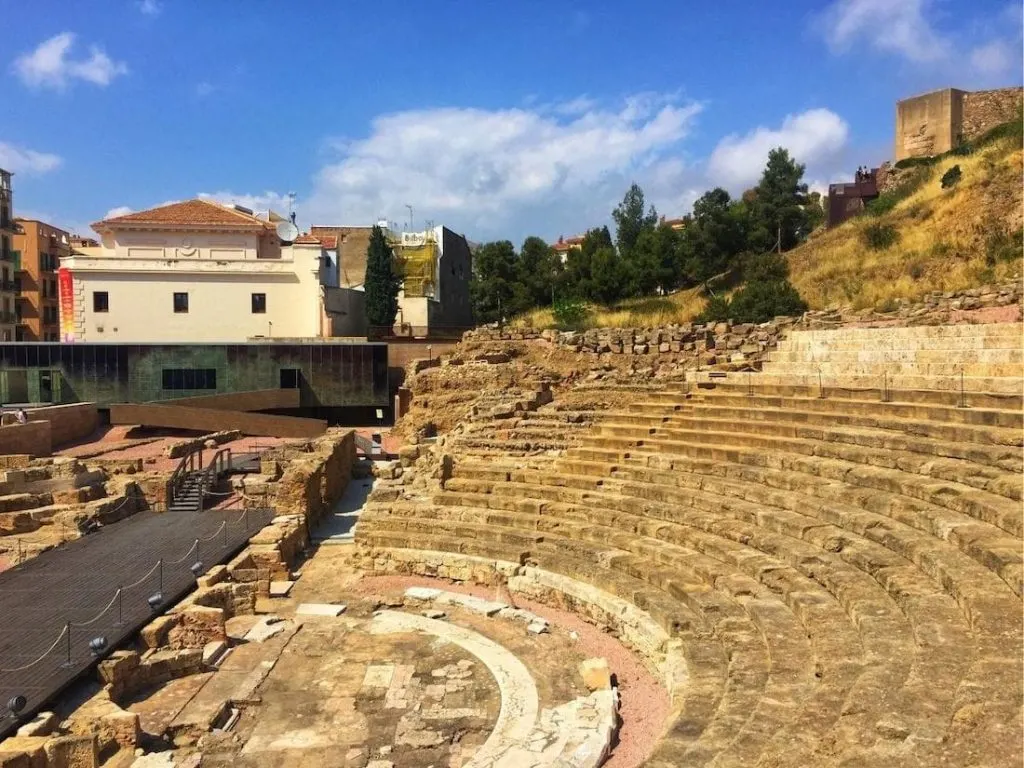
#17. Metropol Parasol in Seville
The majestic Metropol Parasol is a grand wooden structure found at La Encarnación square, in the old part of Seville. Its ultra-modern composition stands in abrupt contrast to its medieval surroundings – but the neutral tone helps fuse them today, making it one of Spain’s most famous landmarks.
Designed by German architect Jürgen Mayer and finished in 2011, the Metropol Parasol is said to be the largest wooden structure in the world. It’s hard to believe the entire thing is just made from bonded timber with a polyurethane coating.
As you might imagine, the structure is very controversial – not only due to its appearance and location but thanks to cost overruns and several delays in its construction. However, today, on a sunny day, the stairways and storefronts under the teeming with life as locals and tourists explore the museum, farmers market, and restaurant housed within. There is even an elevated rooftop promenade positioned on top of the parasol for guests to enjoy Seville’s best views.
Like the Sydney Opera House or modernist carparks of Miami, this is a contemporary structure that has come to symbolize the city of Seville. Don’t miss it on your travels in Spain – the Metropol Parasol is truly a beautiful, artistic work of engineering and craftsmanship.
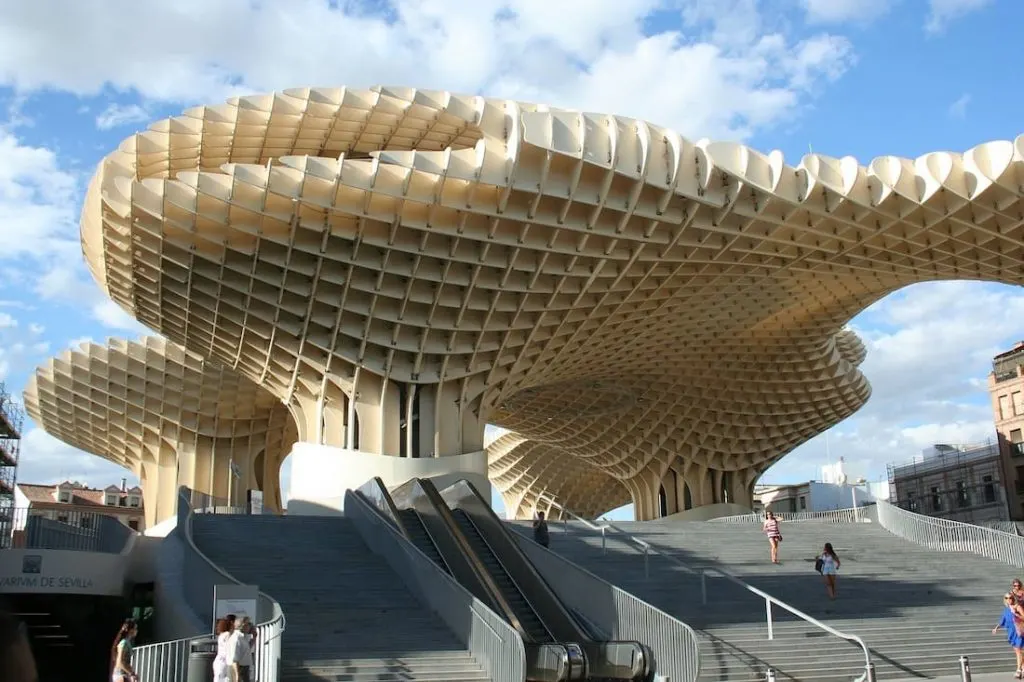
#18. Timanfaya Park in Lanzarote
Timanfaya National Park is a 5000 hectares of protected land situated near the west coast of Lanzarote islands in Spain. Covered with lava and volcanic features in various shapes and hues, Timanfaya is a UNESCO biosphere reserve and one of the top tourist attractions in Lanzarote.
Sometime between 1730 and 17376, more than 100 volcanic eruptions happened for continuous six years. The scale of the eruption was huge, and it claimed the then fertile land, villages, and the sea. Timanfaya National Park – as what we see now is a spectacular volcanic landscape and a testimony to the mass volcanic eruption that happened more than 300 years ago. Needless to say, the landscape, that covers a quarter of Lanzarote, is straight out of Martian movie, and makes you wonder if you are on Mars or Earth!
Although the mountains are now volcanically dormant, temperate down under the earth at a depth of 13 meters still remains to be 610 degrees Celcius! And the temperature below 10 cm stays at 277 degrees. There are live demonstrations at the main Montanas del Fuego Centre (Fire Mountain), where you can see how pouring a bucket of cold water into the hole gushes out the steam with a fizzing sound. Its a spectacle to watch! At the nearly El Diablo Restaurant, you can witness how they use this geothermal heat for cooking by placing a large grill over a deep pit.
Visitors are not allowed to drive, roam or hike Timanfaya National Park on their own. But you can use the free coach tour that comes with the National Park’s entrance fee. The coach navigates through the remotest parts of National park – known as Ruta de Los Volacanes. Alternatively, there is a camel tour, and a restricted walk/hike tours available.
There is no public transport to reach Timanfaya National Park. Hiring a car or arranging a tour is the best option. If you are driving, the national park is located on LZ-67 that connects Yaiza and Mancha Blanca. Pay the entrance fee (12Euro per adult and 6Euro per child aged 7 – 12), and you will drive through a narrow snaking path that reaches the car parking lot of Montanas del Fuego.
Explored by Anuradha from Country Hopping Couple
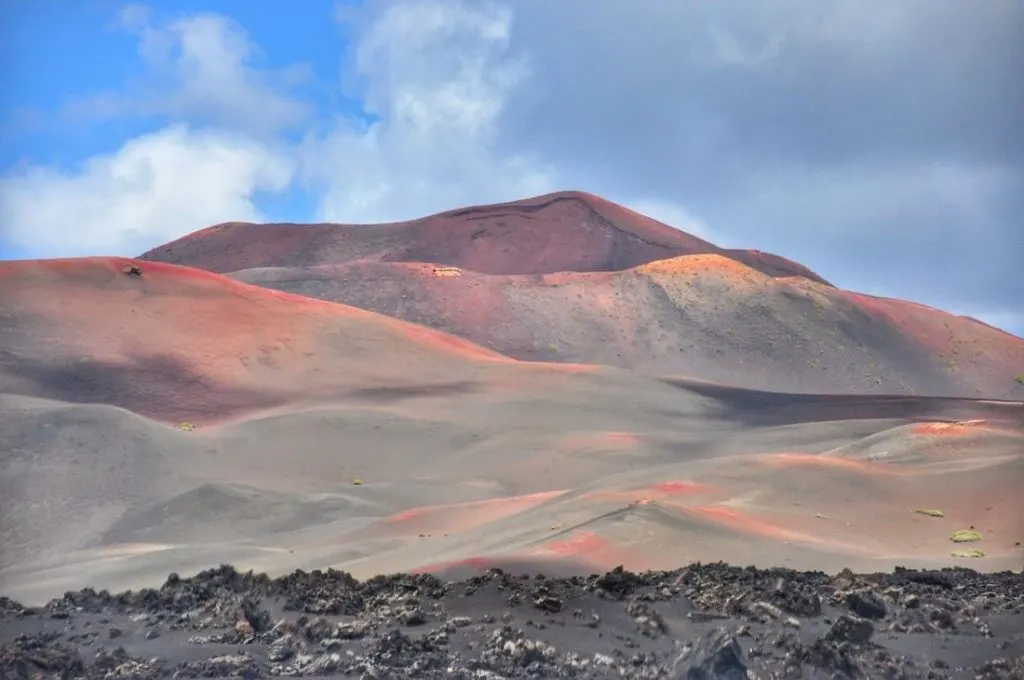
#19. Benidorm Skyline
Benidorm is one of the most famous places in Spain. The region is known for its perfect climate, especially during our winter. Because of that, Benidorm is the place to be for retired people who want to escape the cold.
Benidorm started as a small fishing village, but in 1956 they got permission to construct skyscrapers. One skyscraper after another was built. A few decades later, the skyline of Benidorm became a phenomenon. You love it, or you hate it.
Benidorm ranks third in terms of the concentration of tall buildings in Spain. But if you compare the number of skyscrapers with the number of inhabitants, Benidorm is one of the leaders in the world.
If you’re not retired yet, I would advise you to stay only 1 or 2 days in Benidorm. Choose the Level at Melia Villaitana. This hotel is situated uphill, away from the crowds. It’s a five-star hotel, has lovely pools and charming rooms. It looks like a small Italian village. So no skyscrapers over here. From the hotel, you have a first view over the Benidorm Skyline.
The best place to see the Benidorm Skyline is ‘The Balcony of the Mediterranean” or ‘The Castle Viewpoint.’ From here, you will enjoy a spectacular view of the bay and the skyline.
The entrance to the viewpoint is to be found in the old town between the famous beaches Poniente and Levante.
Explored by Wendy from WorldWideWendy
![]()
#20. Mezquita-Catedral in Córdoba
The Mezquita-Catedral in Córdoba was originally commissioned in 785 CE by Abd al-Rahman, ruler of the Islamic Caliphate in Europe, as a large mosque (Mezquita). The Mezquita would take 200 years to complete, but its notoriety would come from one of the most controversial extensions in the world.
In 1236, Christian’s invaded Córdoba and converted the Mezquita into a church by adding chapels and Christian icons. But in 1523, King Carlos V authorized a cathedral to be built within the Mezquita, forming the incredible World Heritage site you see today: a towering Christian cathedral bursting through the roof of the expansive Islamic prayer hall. Interrupting the mesmerizing rows of Roman-inspired arches that distinguish this prayer hall from all others, the imposing Cathedral is a symbol of religious power.
It’s a fascinating building and one of the most iconic landmarks in Spain. The unquestionable highlight of the Mezquita-Catedral is the Mihrab prayer niche. Lit from a dome portal, it appears alive, sparkling with gold and framed by intricate horseshoe-shaped carvings. The octagonal Chapel of Santa Teresa is a master-class in Baroque architecture – dazzlingly white plasterwork showcasing works of religious art. But it’s the richly decorated Cathedral towering through the center of the simple Islamic prayer hall that makes this building such an interesting place to visit.
The Mezquita-Catedral is located in the center of Córdoba, and entry is free each morning (except Sundays) from 8:30 AM to 9:30 AM. All other times, entry is €10. To fully appreciate the scale of this iconic landmark, climb up the bell tower for a bird’ s-eye view (€2). By train, Córdoba is 50 minutes from Malaga or 45 minutes from Seville.
Explored by Paul Healy from Anywhere We Roam
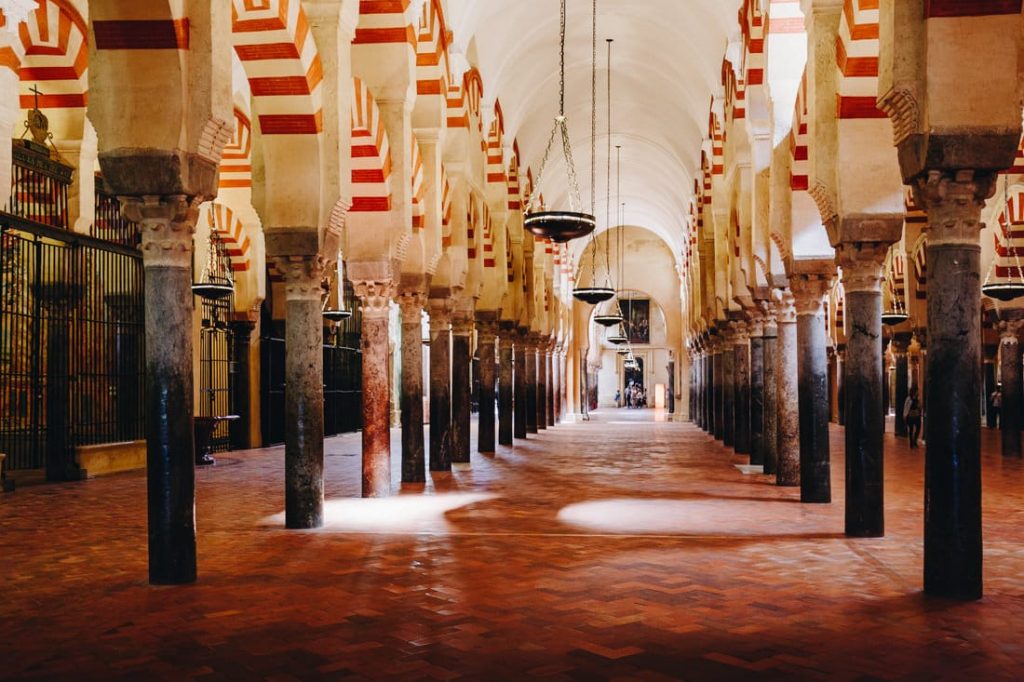
#21. The Alcazaba of Malaga
The Alcazaba is, without a doubt, Malaga’s number one touristic attraction that offers not only a history lesson about the times this land was under the Moorish occupation, but also a wonderful experience in the shade and, beautiful views over the entire coast.
Malaga’s Alcazaba is part of a bigger medieval complex, with the ruins of the Roman theatre at its foothills, and the Gibralfaro Castle on the hill above. With over 100 towers, the Alcazaba is one of the best examples of Moorish fortresses in the entire Spain, that still stands tall pretty much as it was in its glory days. In fact, it is one of the best examples of an advanced Arab military fort in the country. The Alcazaba was well equipped to protect from attacks coming from the sea, and a very difficult fortress to conquer. It took a four months siege for the King Ferdinand of Aragon and Queen Isabella of Castilla to defeat the troops of the Nasrid Kingdom and conquer the city of Malaga.
The Alcazaba had two roles: defense and living quarters. This is why, beyond the three rows of thick walls (out of which only two remain today), you can see beautiful patios shaded by palm and orange trees, Moorish architectural elements such as key whole shaped doorways and intricate sculptures, together with many fountains, pools and water elements. This is because it was built during the Nasrid Dynasty, known for its outstanding palace architecture and garden landscaping.
A ticket to visit the Alcazaba together with the Gibralfaro Castle costs only 5.5 euros, and it is highly recommended on any Malaga itinerary. Because the Alcazaba is located in the city center, no matter where you are staying, you can get to it in a maximum of 15 minutes.
Explored by Joanna from Andalucia in My Pocket
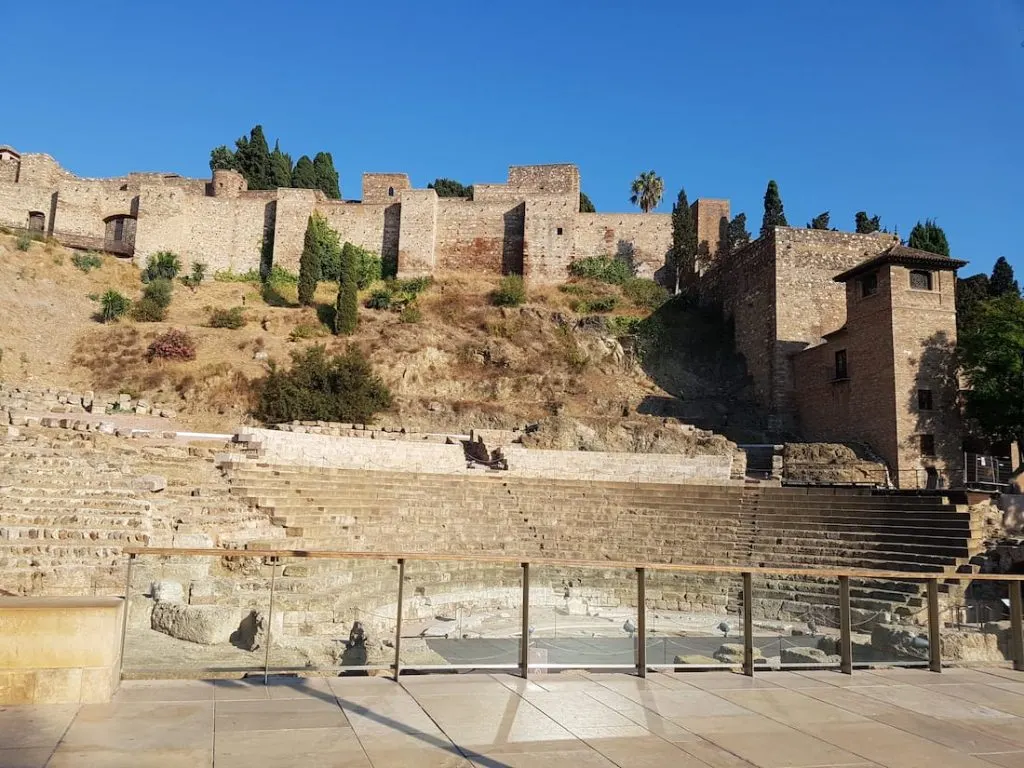
#22. Las Médulas Gold Mines
The gorgeous Las Médulas historic gold-mining site near the town of Ponferrada in the province of León is not only a famous natural landmark of Spain – but a UNESCO World Heritage Site.
It was the most prominent gold mines in the Roman Empire when it was created and the largest open-pit gold mine in the world. The dramatic landscape of Las Médulas emerged from a Roman mining technique termed ruina montium ( quite literally ‘the wrecking of the mountains’). The method engaged was a kind of hydraulic mining that required weakening a mountain with huge quantities of water, which were supplied here by seven long aqueducts from higher rainfall areas.
While it did indeed wreck the mountains, in the proceeding two millennia nature has taken back over, and the forest cover now makes it a place of exquisite natural beauty. A bit like Chernobyl – in the sense that an area of such wholesale destruction by man can then be reclaimed by nature.
Large-scale gold production took place in the second half of the 1st century AD and lasted for around 250 years, over which 6,500 kilograms of gold were extracted each year. Today, part of the aqueducts are still preserved, but the highlight is the otherworldly rock outcrops – which are not natural but a result of this undermining of mountains by an army of slaves using this water.
It’s incredibly beautiful, especially in the soft light of sunset – and one of the more bizarre landscapes you’ll find anywhere in the world. The honeycombed Las Médulas Gold Mines would look more at home in Australia then Spain…
Plan to spend a day exploring the various hiking trails on offer and to appreciate its charm in the later afternoon light.

#23. El Capricho De Gaudí in Cantabria
The “Master of Modernism” Antoni Gaudí is, of course, best known for his nature-inspired designs in Barcelona (including La Sagrada Familia, La Pedrera, and Casa Batlló), but you can also find a handful of his works outside the Catalan capital. One of the most colorful and interesting designs from his early career is located in the gorgeous little Cantabrian town of Comillas, in the verdant lands of northern Spain.
Translating as “The Caprice,” or perhaps more appropriately “The Whim,” El Capricho is an ambitious architectural marvel designed and built between 1883 and 1885. Like many of the colossal show-homes found in this nook of the country, its purpose was to demonstrate just how filthy rich its owner Máximo Díaz de Quijano had become thanks to his law practice in Cuba. But more than that, like his fellow newly-minted “Indianos,” who made vast fortunes in the “New World,” Díaz de Quijano also wanted to show off the good taste and sophistication he’d garnered while filling his bank account.
The countless ceramic sunflowers that adorn the facade hint at the chore concept, while the internal layout inspires inhabitants to follow the sun from room to room in the same way that sunflowers turn to face the sun throughout the day. As with many of Gaudí’s house designs, the design incorporates its owner’s personal interests – and further develops the mishmash of classical design concepts that Gaudi drew on for his previous project Casa Vicens in Barcelona.
Máximo Díaz de Quijano’s passion for music, for example, is reflected by the sinuous wrought-iron balconies that float across the facade like musical notes. Open the windows in the music room, and they chime and “sing” as if welcoming in the sun. The “romance garden” is equally as colorful and impressive, with meandering footpaths and cozy corners where Quijano could canoodle to his heart’s content.
But, alas, neither love nor music was on the cards for Quijano, who died at the tender age of 44, just a week or so after moving into this beautiful property. Interestingly, Gaudí never actually visited or saw the finished house in person.
Explored by Ben Holbrook from DriftwoodJournals.com

#24. The Roman Amphitheater in Tarragona
The city of Tarragona is commonly referred to as the “Rome of Spain.” It has a charming old town, ruins from the Roman circus, a well-preserved Roman amphitheater, and so much more. The Tarragona Amphitheater will have you feeling like you transported back to the 2nd century when it was built. It was then that the amphitheater hosted gladiator fights and other large events. What makes it so unique is the backdrop of the stunning beaches.
Visiting the amphitheater is a must if you’re planning a trip to Tarragona and it is easy to get to. If you’re arriving to Tarragona via the train it is only a short walk away. As you’re exiting the station head east. In about five minutes you’ll see it in the distance and in a few more minutes you’ll have arrived. You can also get more of an elevated view of the amphitheater from the “Mediterranean Balcony” although it’s worth the visit walk the grounds. Entry is only 3.30€ per adult and it is open Tuesday through Sunday.
There are so many things to do in Tarragona in addition to visiting the amphitheater. Take a walk along the Roman Walls, head to one of the amazing beaches, stroll the old town, and more! It’s the perfect small-town getaway if you’re looking for an underrated destination. It’s also v very accessible as it’s only an hour’s train ride away from Barcelona. It makes for a nice day trip or an overnight visit.
Explored by Jeanine Romo from Le Wild Explorer

#25. Colomares Castle in Benalmadena
Are you looking for one of the best places to visit in Spain? Then what are you waiting for? Colomares Castle is the best destination for you to visit. Colomares Castle is located in Benalmadena, Spain.
Though there are many exciting things to do in Benalmadena but a visit to Colomares Castle is a must-watch. The castle is locally known as “Castillo de Colomares “which exhibits the adventures and life of Christopher Columbus. You can reach there by heading down towards Carretera Costa del Sol from the traffic lights in Benalmadena. From there, you can take a 10-minute walk and reach the castle.
Colomares cover an area of 1500 meters, making it the largest monument across the world. Colomares castle is not just a monument but a fairy tale style structure demonstrating architectural finesses and expertise. One can never guess that it has been built by a doctor and two local architects. Dr. Esteban Martín Martín, who belonged to the United States, was amazed because of the lack of information on explorer Christopher Columbus who discovered America. The castle was built between 1987 to 1994 and pays homage to the great discoverer.
The entire structure of the castle is precisely carved with discoveries of Columbus, making it iconic in its own way. Colomares castle has towers of over 30 meters along with gardens, sculptures, and stone vessels. You would be surprised to know that the castle has a church inside which is only 1.96 square meters in area and is listed as the smallest church in ‘The Guinness Book of World Records.’ It is always advisable to book tickets online and start the journey towards the castle in early opening hours as it takes time to visit the entire place.
Explored by Paulina from Paulina On The Road
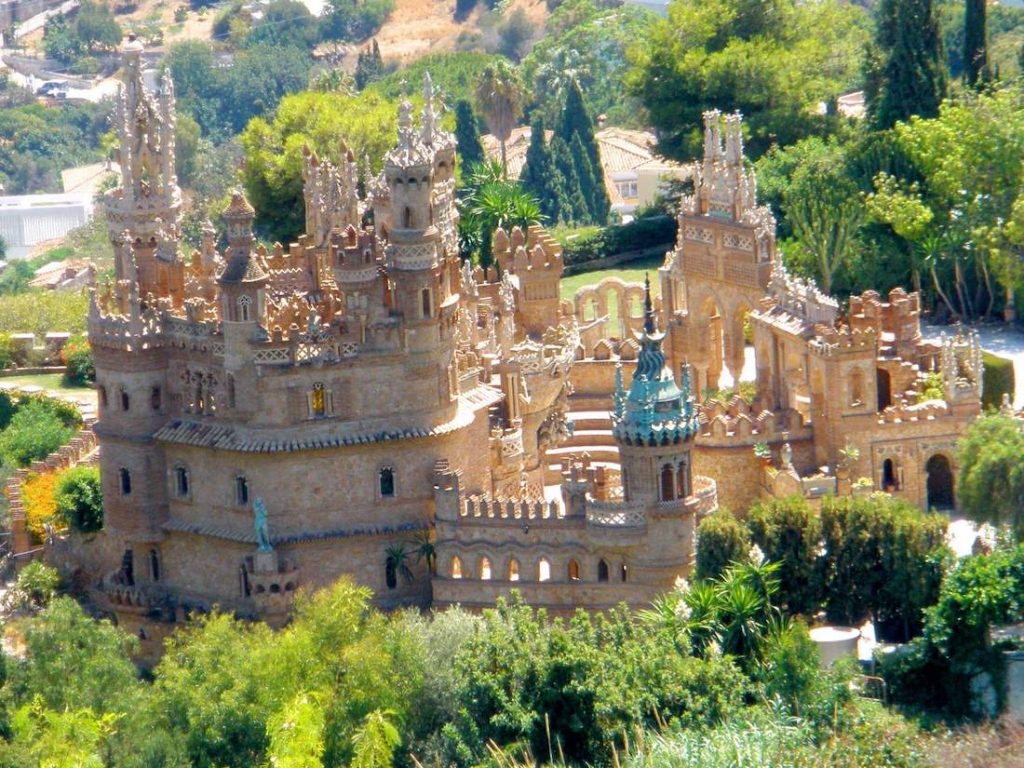
#26. The Alcazar in Cordoba
The Alcázar of the Christian Kings is a medieval palace built in the historic center of Córdoba. This castle was once the residence of the Spanish Catholic kings. During the reign of Queen Isabella and King Ferdinand, it also served as the Holy Office headquarters during the Spanish Inquisition.
Córdoba was once a city of significance, founded in 152 BC by the Romans. It became the largest city in Europe where Christians, Jews, and Muslims peacefully coexisted for hundreds of years. The architecture of Córdoba reflects a blend of these cultural groups that occupied the area, and the historic center of Córdoba is a UNESCO World Heritage Site recognized for its historic religious architecture.
The Córdoba Alcázar is striking in its own rights and features a stunning Hall of Mosaics and several beautiful courtyards. Though, the garden is really what makes the Alcázar a stand-out among the beauty of Córdoba. It features beautiful fountains, ponds, and many citrus and palm trees, and its large paths are lined with cypress trees. The magnificent outdoor garden is surrounded by the four towers of the Alcázar. You can climb the towers and walk along the ramparts to enjoy views of the city outside the palace and this beautiful garden.
Córdoba may be lesser-known than some of the other Spanish cities, though it features some of the most stunning Moorish architecture in Europe. It lies between Madrid and Seville and is a worthy stop between these two popular and magnificent cities. You can drive, though the fastest and easiest way to Córdoba is on the high-speed Renfe AVE train.
There are a number of beautiful places to see in Córdoba that are not to be missed, including the Mosque of Córdoba (also known as the Mezquita), the Roman Bridge of Córdoba, and wandering around the Jewish Quarter. One of the most stunning in a city of striking beauty is the Córdoba Alcázar.
Explored by Sam from My Flying Leap
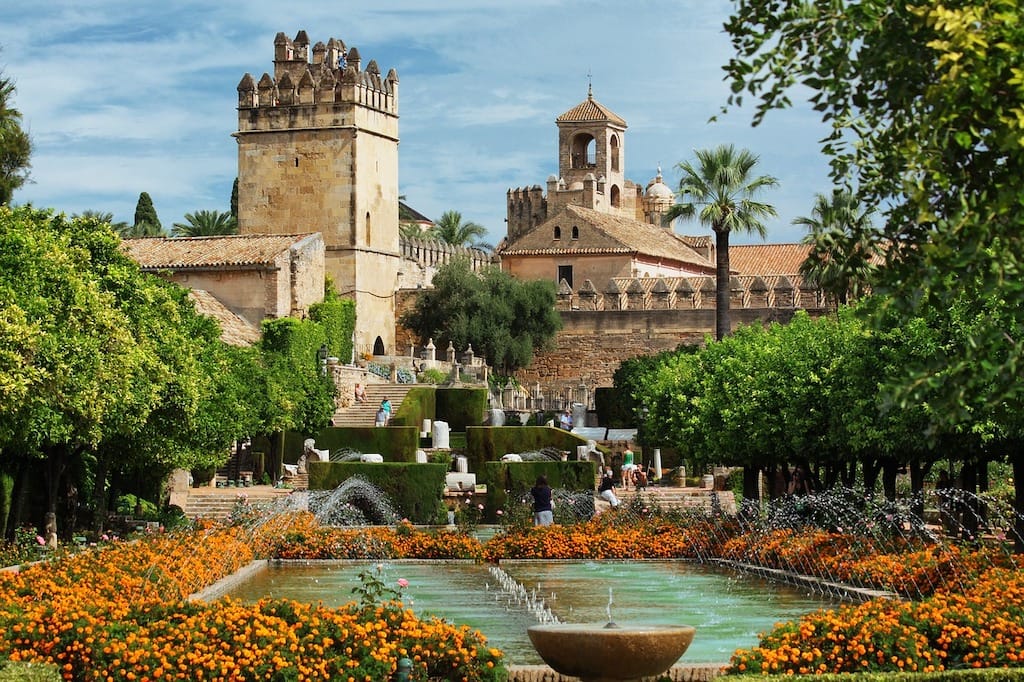
#27. La Sagrada Familia in Barcelona
Of all Antoni Gaudi’s famous architectural wonders in Barcelona, La Sagrada Familia is one of his grandest (and still not completed) landmarks. A stunning basilica located in the historic district of Barcelona, La Sagrada Familia is the Basilica of the Holy Family located in the Eixample district and designed by the famous Catalan architect.
Initially started in 1882 and later taken over by Gaudi as the head architect, the design influences of the Basilica combine Catalan Art Nouveau and gothic style. Buried in the crypt of the church, Gaudi devoted the end of his life to this stunning architectural wonder, which is inscribed as a Unesco World Heritage site along with all of his other gorgeous buildings throughout the city.
It is anticipated to finish at the century mark of Gaudi’s death in 2026, but you can view an incredible portion of the exterior and interior of this incredible church. Expect to find long lines to get in, so the best advice is to get their early or late or book reservations in advance so you can avoid the wait. You can take a decent tour or do a DIY audio tour to give you more insight into the design, build, and other detailed histories about this magnificent building to honor Gaudi.
If you are planning on visiting more of Barcelona, check out my post on the free things you can do in Barcelona here for more inspiration and ideas on what to see and do around the city.
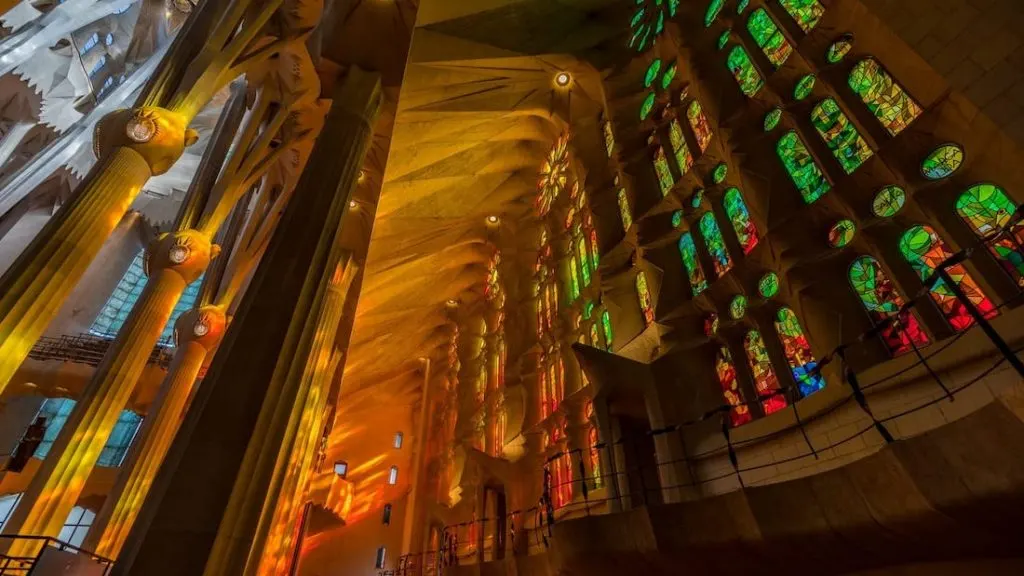
#28. The Aqueduct of Segovia
Segovia is one of the most beautiful cities in Spain. This fortified city in the region of Castile and Leon is home to several historic landmarks, including an impressive Roman aqueduct.
Built around 112AD, the elevated aqueduct of Segovia is one of the best-preserved structures of its kind in the world, despite having been partly destroyed and rebuilt several times throughout the centuries. It is the most iconic landmark in Segovia, so much so that it features on the city’s coat of arms.
The aqueduct is erected on two levels, with 167 arched in total, and was originally built to transport water from a nearby river. The almost intact ruins of the aqueduct measure up to 28 meters and stretch for nearly 730 meters. There is a niche at each end of the aqueduct, one of which is believed to have originally contained an image of Hercules. According to legend, Hercules was the founder of the city.
The aqueduct is situated in Plaza del Azoguejo, which is a good starting point for your tour of Segovia. There are several bus stops right next to the aqueduct, so it’s probably the first thing you see upon arriving in Segovia.
Start by taking in views of this magnificent structure from the Plaza, then head up the steps by the side of the square to enjoy more beautiful views of the aqueduct and its surroundings.
At night, the aqueduct is beautifully lit up, and the Plaza is teeming with locals. There are also several restaurants next to the aqueduct, making it the perfect spot for a romantic dinner.
Explored by Daniela from Grumpy Camel
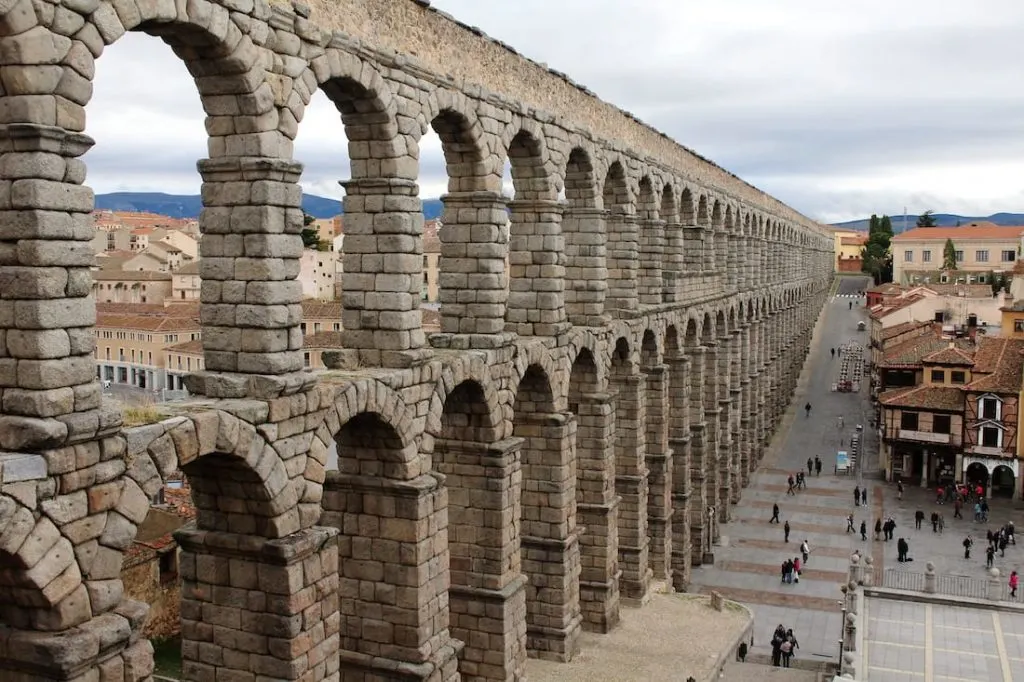
#29. Plaza De Espana in Seville
One of the most magnificent landmarks in Spain is the elegant Plaza de España in Seville. This stunning square is located inside Maria Luisa Park in the heart of the city, and it’s a highlight of any trip to Seville. Seville is a very walkable city, and I recommend staying near this square so that you can get to it easily and also be within walking distance of the other main attractions in the city.
Plaza de España was built in 1928 for the Ibero-American Exposition. The architecture inside this square is simply stunning; it’s the main reason why this square is an icon of the city! The semi-circular building around the square showcases a beautiful blend of neo-Moorish and neo-Renaissance architectural styles.
In front of it, you’ll see 48 unique alcoves decorated with charming azulejos (traditional Spanish and Portuguese ceramic tiles). Framing this square are two towers that are so tall, you’ll be able to see them pretty much everywhere you go in Seville!
Plaza de España is also often dubbed as “the Venice of Seville” because there’s a very picturesque canal in the middle of the square. The best part is that you can even rent a boat and row around! The canal will take you all around the square, so you’d be enjoying some spectacular sights — including that of flamenco dancers performing in some parts of the square — as you row around. Curved over the canal are several bridges ornate with beautiful ceramic tiles.
As you can imagine, Plaza de España is a photographer’s dream. Every corner of this square is incredibly photogenic, and you can find many creative angles as you walk around. My insider’s tip is to arrive at this square early in the morning right after sunrise so that you can take some photos and enjoy the architecture without any crowds around!
Explored by Jiayi Wang from The Diary of a Nomad
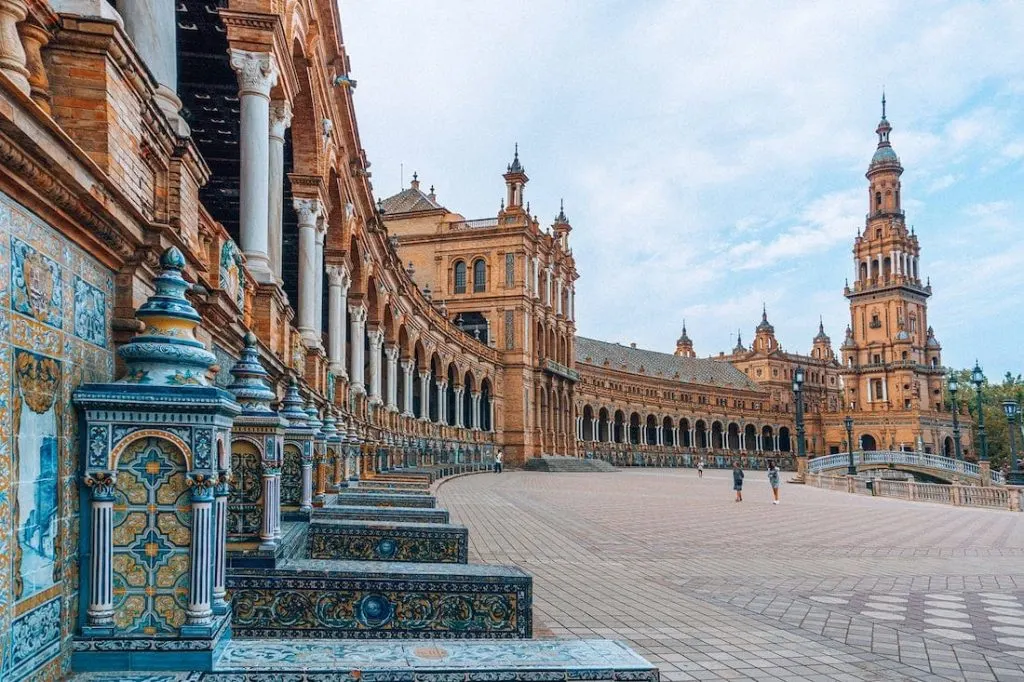
#30. Parc Guell in Barcelona
Barcelona is a haven for those who love quirky architecture, and one of the must-visits is definitely Gaudi’s Park Guell. While Gaudi’s best-known work is the Sagrada Familia, this colorful tourist attraction is a close second. Park Guell has been designated a World Heritage Site in 1984 and is one of Gaudi’s most celebrated masterpieces.
Park Guell is visually stunning. Originally meant as part of a housing block, it ended up with whimsical shapes and colors that captured Gaudi’s imagination and individualistic style. Expect to find gargoyles serving as water spouts, pavilions reminiscent of a candy cane house, a lizard fountain, snake-shaped stone benches that are both ergonomic and serves a social purpose, and over 80 stone columns decorated with mosaics (don’t forget to look up!).
Perched on Carmel Hill, in the neighborhood of Las Salut, Park Guell offers sweeping views of the city. You can walk there from Sagrada Familia (just over 30 minutes, but be warned it’s a gently sloping uphill walk), but it’s also accessible by bus.
Entrance is free; you can take a photo of Park Guell without paying a fee. However, if you want to go up to the Nature Square (with the iconic view of the pavilions), as well as the other areas, including the Hypostyle Room (the stone columns) and the museum, you need to pay a fee.
Barcelona is one of the most touristic cities in Spain. If you want to enjoy Park Guell without the crowd, go early in the morning as soon as they open.
Explored by Aleah Taboclaon from Solitary Wanderer
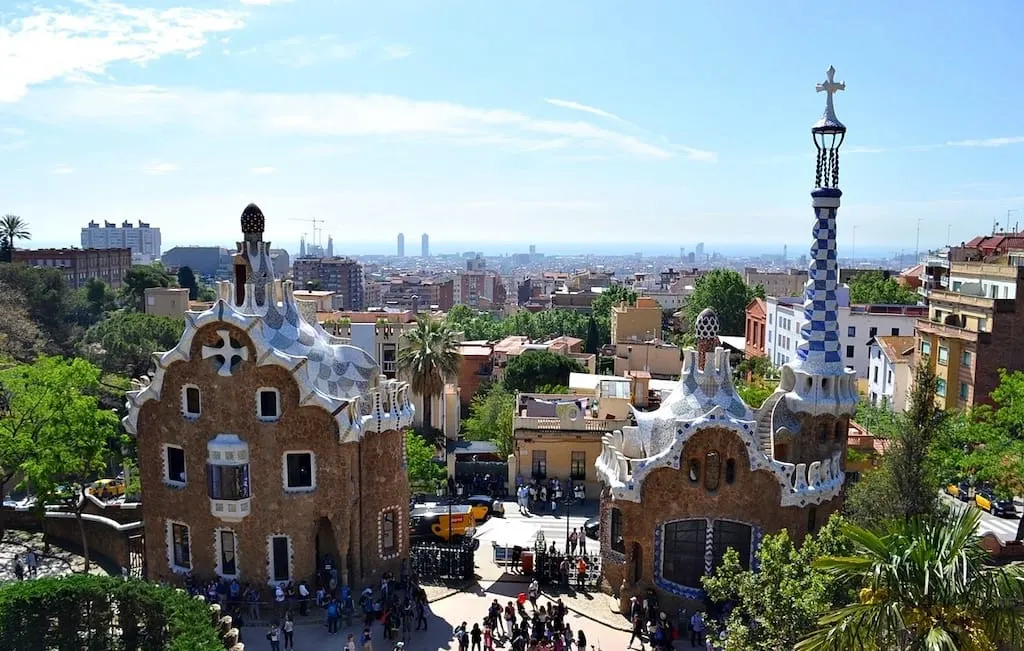
#31. The City of Arts and Sciences in Valencia
The City of Arts and Sciences is a futuristic cultural complex designed by the world-renowned architect Santiago Calatrava. It is one of the top places to visit in Valencia, and it is included in the ’12 Treasures of Spain’ list.
It was built in the bed of the old River Turia, which was drained and rerouted out of the city after the tragic flood of 1957. The old riverbed has now been turned into a green park that snakes through the city, and part of it is occupied by the City of Arts and Sciences.
The whole complex will make you feel like you’ve stepped into a space-age film set. The buildings and structures are built with reinforced concrete, and their design plays with both linear and organic forms. You will find shapes that resemble an eye, a ribcage, and a water lily. The complex includes a number of venues. The Palau de Les Artes Reina Sofia is the main building in this mini-city. It is an opera house, and performance and arts center in the shape of an eye, although some people say it looks like a helmet.
Other important buildings are L’Hemisferic, a planetarium, and an IMAX cinema, that when reflected on the water, looks like an eyeball, the Science Museum Principe Felipe, built in the shape of the skeleton of a prehistoric animal, and L’Oceanografic, the largest aquarium in Europe. There are other buildings and structures, one of which is L’Umbracle, an open arched arcade with gardens inside which must not be missed.
To make the most of the City of Arts and Sciences, I’d recommend visiting both during the day and at night. It looks like a completely different place when it’s all lit up. It’s also a great place to enjoy the Valencian sunset, so in reality, any time of the day is the best time to visit.
Explored by Teresa from the Brogan Abroad
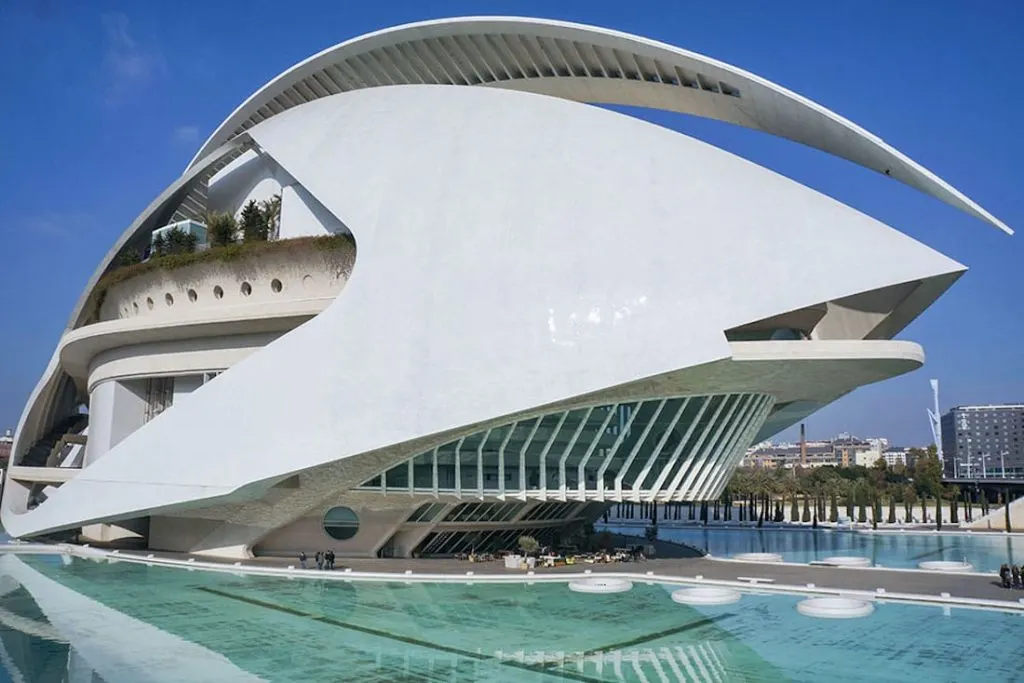
#32. La Seu in Palma De Mallorca
La Seu is one of the most iconic cathedrals in Spain, located on the island of Mallorca, in Palma de Mallorca, the island capital. It was built in the 13th century in the gothic style. The beautiful Cathedral has become a symbol of how the Christian re-conquered the island from the Moorish people. It is also known as “Catedral de Mallorca” however;, most people simply refer to it as La Seu.
It’s a dominating landmark in Palma de Mallorca, located near the harbor, visible from several places around the city. La Seu is truly a masterpiece, and even Antoni Gaudi has been part of its grand architecture. It has a total length of 121 meters and 40 meters in width. The nave is 44 meters tall, which makes it one of the largest religious buildings in Europe. It took almost 400 years to finish the structure, after King James I of Aragon ordered it to be built in 1229.
Visitors are allowed inside to admire the grand interior and rose windows. La Seu is full of history and is a must-visit when traveling to Mallorca. It’s very easy to get here by bus, which stops just outside. Additionally, the hop on hop off bus stop here as well. If you walk along the Passeo from the harbor, you can sight the grand Cathedral from a long distance.
If you’re visiting during high season, it’s recommended to purchase skip the line tickets to avoid entry lines. For shoulder season or off-season, there is no need to purchase tickets before visiting.
Explored by Alexander Waltner from Gourmand Trotter
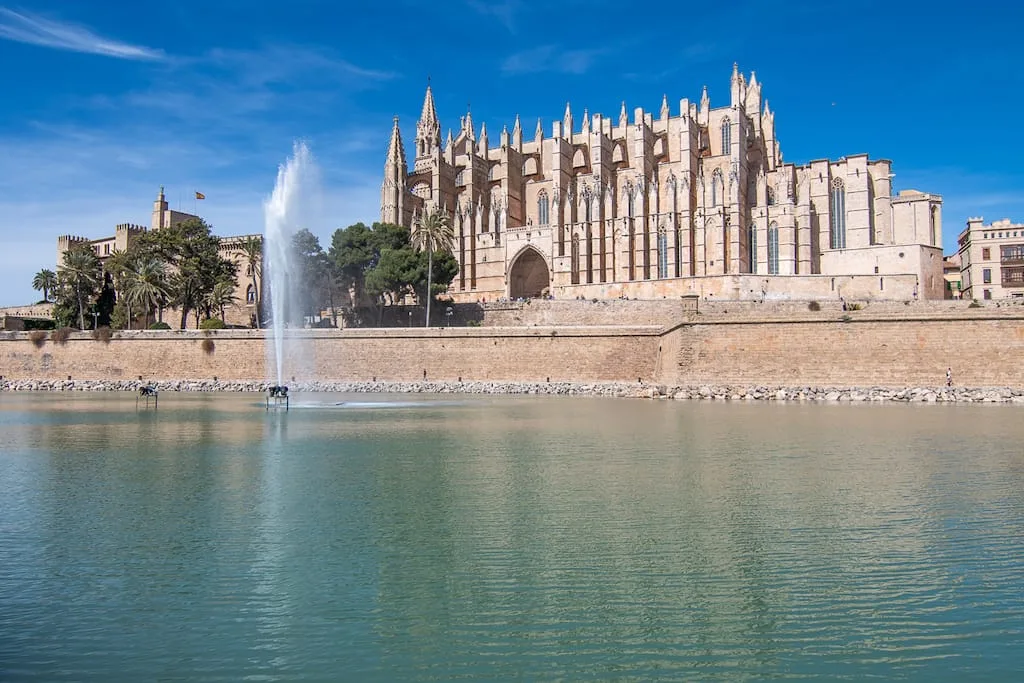
#33. Alcazar of Seville
The Alcazar of Seville is a royal Islamic palace and UNESCO World Heritage Site in Seville, Spain. Its unique blend of Spanish Christian and Moorish architecture, including stunning landscaping, fountains, and garden areas, make it a sight to behold and a popular tourist destination in Southern Spain.
The history of the Alcazar goes back to 712, but it became a palace like the one we see today in the 12th century. Luckily, some of the original ornate and colorful Islamic art and architectural aspects were kept intact and added to even once it was claimed by the Catholic kings of Spain in the 13th century.
When planning to visit, it is advised to pre-book your tickets to this architectural work of art so that you are guaranteed entry. However, you are able to wait in line for entry as well – although it may take quite a while to get in or you may not be able to if it is too busy. We arrived an hour before opening to secure a good spot in line and limit the waiting time. Going early also allows you to have more areas to yourself prior to tour groups showing up.
You will want to plan multiple hours to take in the various intricately designed rooms, artwork, and gardens of the Royal Alcazar. And be sure to have plenty of open space on your camera! Afterward, there are many places nearby in the city center to rest your feet and enjoy some tapas. A short walk away is also the Plaza de España, which is worth a visit as well.
Explored by Brooke & Buddy from TrailingAway
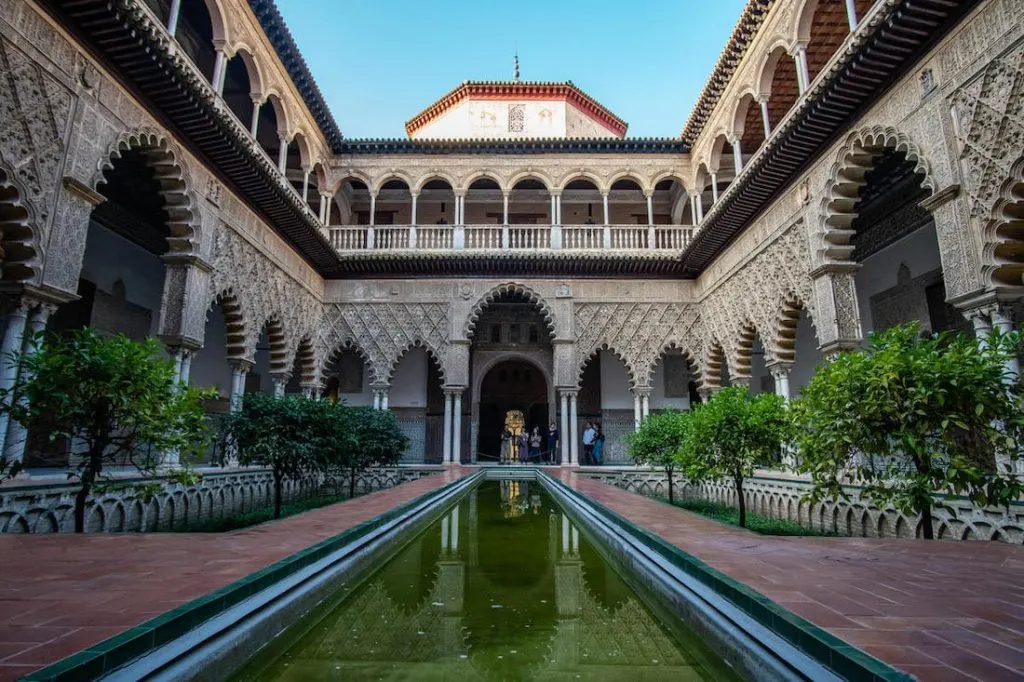
#34. Itallica
Itallica is located 15 minutes from Seville in Santiponce, Spain. Italica was once home to the 5th largest Roman amphitheater in the Empire. Italica grew up in central Spain as a settlement for soldiers who were at war with Hannibal as he made his way towards Rome. It is a large site that will take a few hours to explore.
The amphitheater at Italica held 25,000 spectators during its time. They cheered, and they geared the gladiatorial games. Included in these spectators were the Roman Emperors Trajan, Hadrian, and Theodosius, who were born in Italica.
As of late, the Italica amphitheater has come back into focus thanks to the part it played in Game of Thrones. Italica was the setting for the meeting between John Snow, Queen Cersei, and the Mother of Dragons. It also features in the last episode of Game Of Thrones when Bran was made King of the six kingdoms.
Italica is one of the best things to see in Seville. The easiest way to access Italica is to catch a taxi from Seville; it is only 9 kilometers away. Alternatively, you can catch a bus that drops you out of the front of Italica. The bus back to Seville can be quite infrequent. The entry price is only 2 euros.
Explored by Mark of Wyld Family Travel
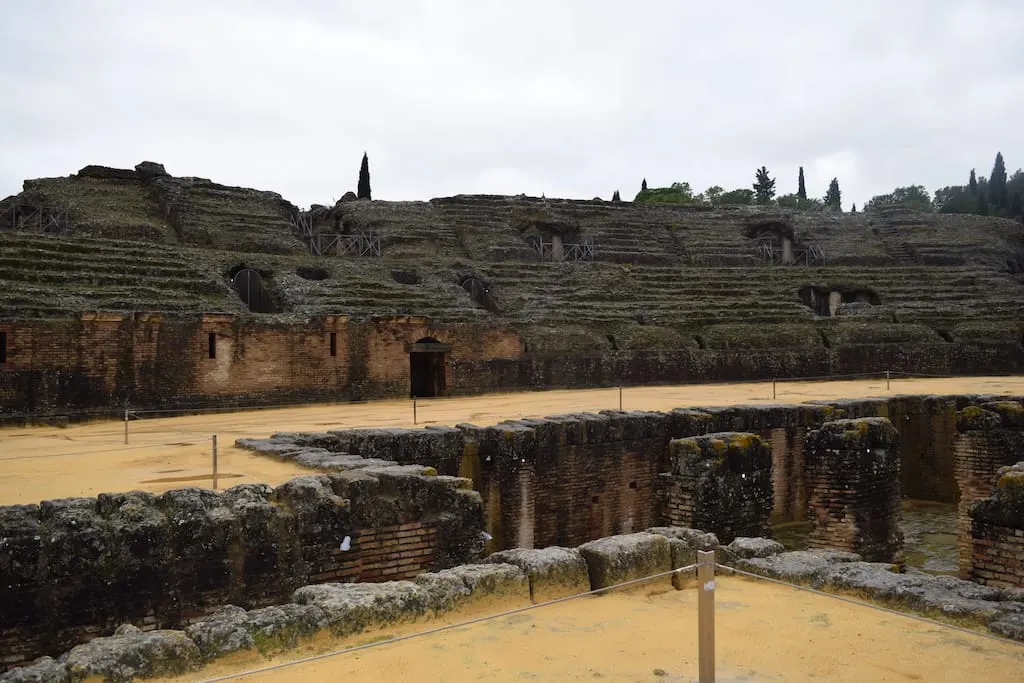
#35. Barcelona City Beach
Barcelona is one of the most popular tourist spots in Spain, and while it has plenty of architectural wonders – the city beaches here are also landmarks of Spain.
Barcelona flaunts several gorgeous beach locations with something for everyone, from those looking to unwind and uncompress, to those looking for dining, swimming, and sports. There is even a gay beach in Barcelona.
La Barceloneta beach is typically Barcelona’s busiest and touristy stretch of sand – being located closest to the city core, while the expansive Nova Icaria beach is one of the most peaceful. There are countless choices, and you can’t go wrong with any of them. Even if you don’t feel like getting covered in sand, you can have a stunning view of this Spanish landmark from the W Barcelona rooftop bar (or your room/infinity pool if you are lucky enough to be staying here).
